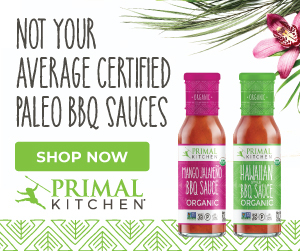Mark Sisson's Blog, page 50
April 10, 2021
Frozen Coconut Macadamia DIY Energy Bars Recipe
Some people feel like they shouldn’t snack, but there are lots of reasons you might reach for something to tide yourself over. Maybe you’re snowed in with work and your schedule was thrown off. You could be a little hungrier than normal from yesterday’s tough workout. You could need a snack because you’re just starting with intermittent fasting or keto as your metabolism is adjusting. Quality snacks are a good thing to have on hand so you’re not caught off-guard. These homemade energy bars are perfect snacks filled with my favorite fats and very low in carbs and sugar.
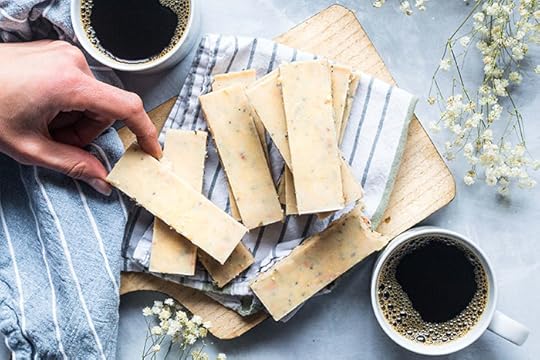
Frozen Coconut Macadamia Bars are incredibly easy to make and have a deliciously decadent flavor and texture. Macadamia nuts and coconut oil add a naturally sweet
taste. Coconut flakes and chia seeds add a crunchiness that contrasts perfectly with the otherwise smooth and creamy texture of the bars.
And, that’s pretty much all there is to these bars! Just pop them into the freezer, and 30 minutes later they’re ready. Keeping the bars frozen is essential – if left out too long they’ll start to melt. The cold texture is partly what makes them so delicious, almost like a keto ice cream bar.Feel free to add more chia seeds if you’d like. You can also drizzle some nut butter or dark melted chocolate on the bars if you’d like.
Feel free to add more chia seeds if you’d like. You can also drizzle some nut butter or dark melted chocolate on the bars if you’d like. Make sure to keep them stored in the freezer so they stay firm and solid. We used thick pieces of dried coconut, but you can use thinner flaked coconut as well.
Frozen Coconut Macadamia DIY Energy Bars Recipe

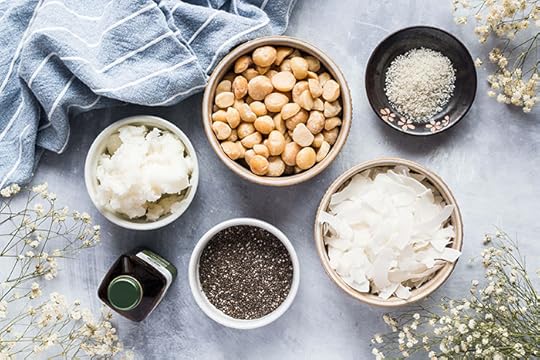
Instructions:
Preheat your oven to 350 degrees Fahrenheit. Lay the coconut out on a sheet pan or baking dish and let it toast for 5-15 minutes, or until the coconut is golden.
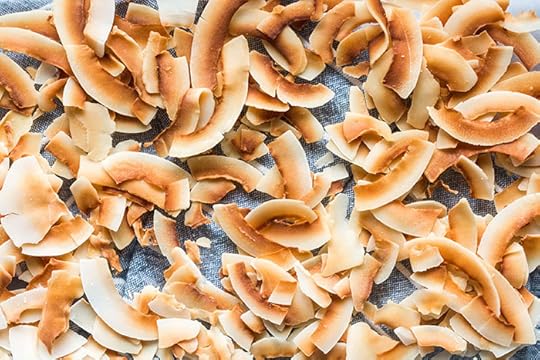 The length of time it takes for the coconut to toast will depend on its size and thickness, so watch it closely to prevent burning. Once the coconut is toasted to your liking, remove it from the oven and allow it to cool.
The length of time it takes for the coconut to toast will depend on its size and thickness, so watch it closely to prevent burning. Once the coconut is toasted to your liking, remove it from the oven and allow it to cool.
Place the macadamia nuts in a food processor and blend. Once the nuts begin to crumble and turn into a paste, add the coconut oil and process until smooth. You may need to scrape the sides of the food processor down once or twice in between processing.

Add the toasted coconut, chia seeds, vanilla and salt and pulse or blend until a chunky paste forms, or until the coconut is just incorporated into the macadamia mixture.
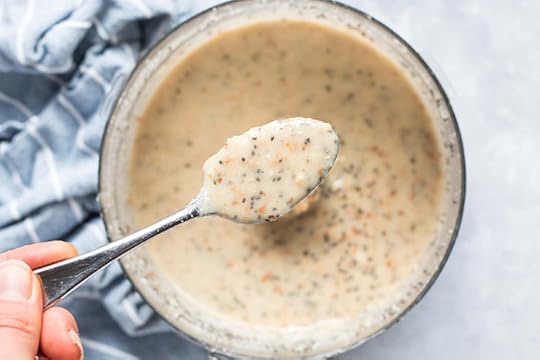
Line a 8”x8” pan with parchment paper and pour the macadamia mixture in. Place the pan in the freezer for at least 30 minutes.
Take the pan out of the freezer and lift the parchment out. Use a knife to cut the macadamia coconut square into 12 or 16 pieces.
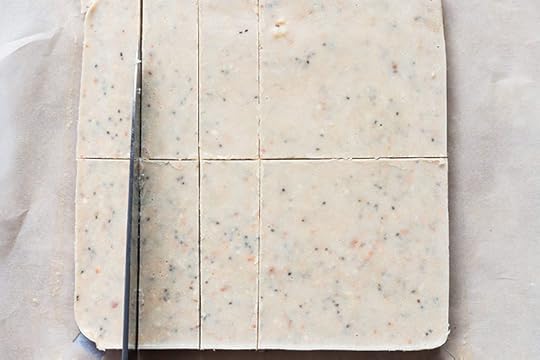
Keep leftover pieces in the freezer.
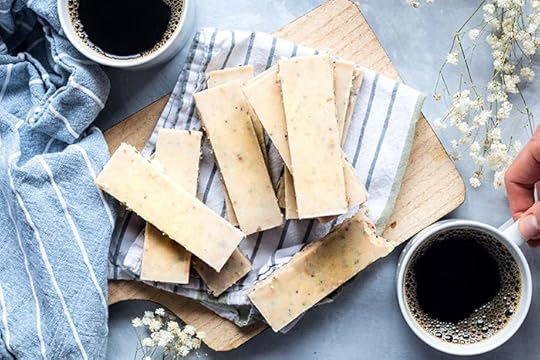
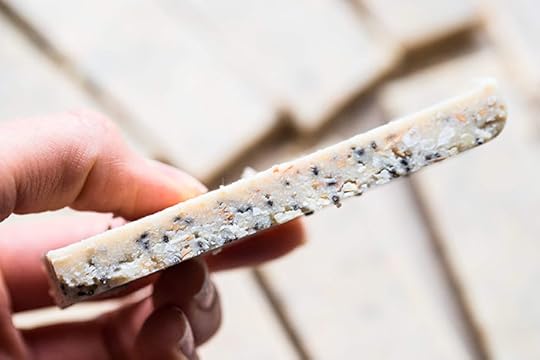
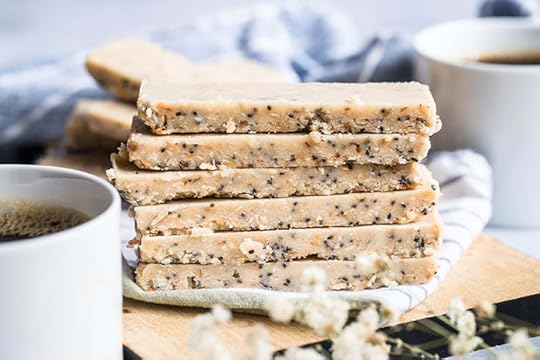
 Print.tasty-recipes-image{float:right}.tasty-recipes-yield-scale{border:1px solid #979599;border-radius:2px;color:#979599;margin-left:3px;padding:0 4px;font-size:.7rem}.tasty-recipes-scale-container{float:right;padding:0 0 1rem;display:flex}.tasty-recipes-scale-container .tasty-recipes-scale-label{text-transform:uppercase;font-size:.6rem;color:#979599;align-self:center}.tasty-recipes-scale-container button{background:transparent;border:1px solid #979599;border-radius:2px;color:#979599;margin-left:5px;padding:2px 4px}.tasty-recipes-scale-container button.tasty-recipes-scale-button-active{color:#353547;border-color:#353547}.tasty-recipes-scale-container button:focus{outline:none}.tasty-recipes-instructions-header{display:flex;flex-wrap:wrap;justify-content:space-between;align-items:baseline;margin:2em 0}.tasty-recipes-entry-content .tasty-recipes-instructions h3{margin:0 0 1rem}@media only screen and (min-width:520px){.tasty-recipes-entry-content .tasty-recipes-instructions h3{margin:0}}button[name=tasty-recipes-video-toggle]{margin:0;padding:0;width:86px;height:30px;border-radius:2px;border:#979599;display:inline-block;line-height:20px;vertical-align:middle;text-align:center;font-size:14px;background:#979599}button[name=tasty-recipes-video-toggle] span{padding:0 4px;pointer-events:none}button[name=tasty-recipes-video-toggle][aria-checked=false] :last-child,button[name=tasty-recipes-video-toggle][aria-checked=true] :first-child{background:#fff;color:#979599;border-radius:2px;padding:2px 4px}button[name=tasty-recipes-video-toggle][aria-checked=false] :first-child,button[name=tasty-recipes-video-toggle][aria-checked=true] :last-child{color:#fff}label[for=tasty-recipes-video-toggle]{text-transform:uppercase;font-size:.6rem;padding-right:8px;color:#979599;line-height:30px;user-select:none;vertical-align:middle;-moz-user-select:none;-ms-user-select:none;-webkit-user-select:none;-o-user-select:none}.tasty-recipe-responsive-iframe-container{margin:10px 0}.tasty-recipes-print-button{background-color:#667;display:inline-block;padding:.5em 1em;text-decoration:none;border:none}.tasty-recipes-print-button:hover{background-color:#b2b2bb;display:inline-block;padding:.5em 1em;text-decoration:none}a.tasty-recipes-print-button,a.tasty-recipes-print-button:hover{color:#fff}.tasty-recipes-equipment{display:flex;flex-wrap:wrap;justify-content:space-evenly}.tasty-recipes-equipment>h3{flex:0 0 100%}.tasty-recipes-equipment .tasty-link-card{flex:0 0 50%;padding:1.5rem 1rem;text-align:center}@media screen and (min-width:500px){.tasty-recipes-equipment .tasty-link-card{flex:0 0 33%}}.tasty-recipes-equipment .tasty-link-card p{font-weight:700;font-size:1em;margin-bottom:0}.tasty-recipes-equipment .tasty-link-card p a{color:initial}.tasty-recipes-equipment .tasty-link-card span{font-size:.9em}.tasty-recipes-rating.tasty-recipes-clip-10{-webkit-clip-path:polygon(0 0,10% 0,10% 100%,0 100%);clip-path:polygon(0 0,10% 0,10% 100%,0 100%)}.tasty-recipes-rating.tasty-recipes-clip-20{-webkit-clip-path:polygon(0 0,20% 0,20% 100%,0 100%);clip-path:polygon(0 0,20% 0,20% 100%,0 100%)}.tasty-recipes-rating.tasty-recipes-clip-30{-webkit-clip-path:polygon(0 0,30% 0,30% 100%,0 100%);clip-path:polygon(0 0,30% 0,30% 100%,0 100%)}.tasty-recipes-rating.tasty-recipes-clip-40{-webkit-clip-path:polygon(0 0,40% 0,40% 100%,0 100%);clip-path:polygon(0 0,40% 0,40% 100%,0 100%)}.tasty-recipes-rating.tasty-recipes-clip-50{-webkit-clip-path:polygon(0 0,50% 0,50% 100%,0 100%);clip-path:polygon(0 0,50% 0,50% 100%,0 100%)}.tasty-recipes-rating.tasty-recipes-clip-60{-webkit-clip-path:polygon(0 0,60% 0,60% 100%,0 100%);clip-path:polygon(0 0,60% 0,60% 100%,0 100%)}.tasty-recipes-rating.tasty-recipes-clip-70{-webkit-clip-path:polygon(0 0,70% 0,70% 100%,0 100%);clip-path:polygon(0 0,70% 0,70% 100%,0 100%)}.tasty-recipes-rating.tasty-recipes-clip-80{-webkit-clip-path:polygon(0 0,80% 0,80% 100%,0 100%);clip-path:polygon(0 0,80% 0,80% 100%,0 100%)}.tasty-recipes-rating.tasty-recipes-clip-90{-webkit-clip-path:polygon(0 0,90% 0,90% 100%,0 100%);clip-path:polygon(0 0,90% 0,90% 100%,0 100%)}.tasty-recipes-nutrition ul{list-style-type:none;margin:0;padding:0}.tasty-recipes-nutrition ul:after{display:block;content:" ";clear:both}.tasty-recipes-nutrition li{float:left;margin-right:1em}.tasty-recipes-plug{text-align:center;margin-bottom:1em;display:flex;flex-wrap:wrap;align-items:center;justify-content:center}.tasty-recipes-plug a{text-decoration:none;box-shadow:none}.tasty-recipes-plug a img{width:150px;height:auto;margin:5px 0 0 8px;display:inline-block}.tasty-recipes-footer-content{text-align:center;padding:1.5em}.tasty-recipes-footer-content .tasty-recipes-footer-copy{margin-left:0}.tasty-recipes-footer-content img,.tasty-recipes-footer-content svg{width:60px}.tasty-recipes-entry-content .tasty-recipes-entry-footer h3{font-size:1.25em;margin:0 0 .25em;padding:0}.tasty-recipes-entry-footer p{font-size:.75em;margin:0}.tasty-recipes-entry-footer p a{text-decoration:underline;box-shadow:none;border-bottom:none}@media screen and (min-width:500px){.tasty-recipes-footer-content{display:flex;justify-content:center;align-items:center;padding:1.5em 0;text-align:left}.tasty-recipes-footer-content .tasty-recipes-footer-copy{margin-left:.8em}}@media print{.tasty-recipes-no-print,.tasty-recipes-no-print *{display:none!important}}/* Bold recipe card styles. */ .tasty-recipes{border:5px solid #667;margin-top:6em;margin-bottom:4em}.tasty-recipes.tasty-recipes-has-plug{margin-bottom:1em}.tasty-recipes-plug{margin-bottom:4em}.tasty-recipes-print-button{display:none}.tasty-recipes-image-shim{height:69.5px;clear:both}.tasty-recipes-entry-header{background-color:#667;color:#fff;text-align:center;padding-top:35px;padding-bottom:1.5em;padding-left:2.5em;padding-right:2.5em}.tasty-recipes-entry-header.tasty-recipes-has-image{padding-top:0px}.tasty-recipes-entry-header .tasty-recipes-image{float:none;text-align:center;transform:translateY(-115px);margin-bottom:1em;/* Decide if we need this */}.tasty-recipes-entry-header .tasty-recipes-image img{-webkit-border-radius:50%;-moz-border-radius:50%;border-radius:50%;border:5px solid #667;height:150px;width:150px;display:inline-block;object-fit:cover}.tasty-recipes-entry-header h2{font-size:2em;font-weight:400;text-transform:lowercase;margin-bottom:0;text-align:center;color:#fff;margin-top:0;padding-top:0;padding-bottom:0}.tasty-recipes-has-image .tasty-recipes-entry-header h2{margin-top:-115px}.tasty-recipes-entry-header hr{border:1px solid #b7bbc6;background-color:#b7bbc6;margin-bottom:1em;margin-top:1em}.tasty-recipes-entry-header div.tasty-recipes-rating{text-decoration:none;border:none}.tasty-recipes-entry-header .tasty-recipes-rating:hover{text-decoration:none}.tasty-recipes-entry-header div.tasty-recipes-rating{font-size:1.375em;display:block}.tasty-recipes-entry-header .tasty-recipes-rating p{margin-bottom:0}.tasty-recipes-entry-header span.tasty-recipes-rating{margin-left:0.25em;margin-right:0.25em;color:#fff}.tasty-recipes-entry-header .rating-label{font-style:italic;color:#b7bbc6;font-size:0.6875em;display:block}.tasty-recipes-entry-header .tasty-recipes-details{margin-top:1em}.tasty-recipes-entry-header .tasty-recipes-details ul{list-style-type:none;margin:0}.tasty-recipes-entry-header .tasty-recipes-details ul li{display:inline-block;margin-left:0.5em;margin-right:0.5em;font-size:1em;line-height:2.5em;color:#fff}@media only screen and (max-width:520px){.tasty-recipes-entry-header .tasty-recipes-details .detail-icon{height:0.8em;margin-top:0.4em}.tasty-recipes-entry-header .tasty-recipes-details ul li{font-size:0.875em;line-height:1.75em}}@media only screen and (min-width:520px){.tasty-recipes-entry-header .tasty-recipes-details .detail-icon{height:1em;margin-top:0.6em}.tasty-recipes-entry-header .tasty-recipes-details ul li{font-size:1em;line-height:2.5em}}.tasty-recipes-entry-header .tasty-recipes-details .tasty-recipes-label{font-style:italic;color:#b7bbc6;margin-right:0.125em}.tasty-recipes-entry-header .tasty-recipes-details .detail-icon{vertical-align:top;margin-right:0.2em;display:inline-block;color:#FFF}.tasty-recipes-entry-header .tasty-recipes-details .author a{color:inherit;text-decoration:underline}.tasty-recipes-entry-content{padding-top:1.25em}.tasty-recipes-entry-content .tasty-recipes-buttons{margin-bottom:1.25em;margin-left:1.25em;margin-right:1.25em}.tasty-recipes-entry-content .tasty-recipes-buttons:after{content:' ';display:block;clear:both}.tasty-recipes-entry-content .tasty-recipes-button-wrap{width:50%;display:inline-block;float:left;box-sizing:border-box}.tasty-recipes-entry-content .tasty-recipes-buttons a{text-transform:uppercase;text-align:center;display:block;color:#fff;background-color:#667;font-size:1em;line-height:1.375em;padding-top:1em;padding-bottom:1em;font-weight:bold;margin-top:0;border:none;border-radius:0;text-decoration:none}.tasty-recipes-entry-content a img{box-shadow:none;-webkit-box-shadow:none}.tasty-recipes-entry-content .tasty-recipes-buttons a:hover{background-color:#979599;text-decoration:none}.tasty-recipes-entry-content .tasty-recipes-buttons img{vertical-align:top}.tasty-recipes-entry-content .tasty-recipes-buttons .svg-print,.tasty-recipes-entry-content .tasty-recipes-buttons .svg-pinterest{height:1.25em;margin-right:0.375em;margin-bottom:0;background:none;display:inline-block;vertical-align:middle}@media only screen and (min-width:520px){.tasty-recipes-entry-content .tasty-recipes-button-wrap:first-child{padding-right:0.625em}.tasty-recipes-entry-content .tasty-recipes-button-wrap:last-child{padding-left:0.625em}}@media only screen and (max-width:520px){.tasty-recipes-entry-content .tasty-recipes-button-wrap{width:100%}.tasty-recipes-entry-content .tasty-recipes-button-wrap:nth-child(2){padding-top:1em}}.tasty-recipes-entry-content h3{text-transform:uppercase;font-size:0.75em;color:#979599;margin:1.5em 0}.tasty-recipes-instructions-header{margin:1.5em 0}.tasty-recipes-entry-content h4{font-size:1em;padding-top:0;margin-bottom:1.5em;margin-top:1.5em}.tasty-recipes-entry-content hr{background-color:#eae9eb;border:1px solid #eae9eb;margin-top:1em;margin-bottom:1em}.tasty-recipes-entry-content .tasty-recipes-description,.tasty-recipes-entry-content .tasty-recipes-ingredients,.tasty-recipes-entry-content .tasty-recipes-instructions,.tasty-recipes-entry-content .tasty-recipes-keywords{padding-left:1.25em;padding-right:1.25em}.tasty-recipes-entry-content .tasty-recipes-description p{margin-bottom:1em}.tasty-recipes-entry-content .tasty-recipes-ingredients ul,.tasty-recipes-entry-content .tasty-recipes-instructions ul{list-style-type:none;margin-left:0;margin-bottom:1.5em;padding:0}.tasty-recipes-entry-content .tasty-recipes-ingredients ul li,.tasty-recipes-entry-content .tasty-recipes-instructions ul li{margin-bottom:0.625em;list-style-type:none;position:relative;margin-left:1.5em;line-height:1.46}.tasty-recipes-entry-content .tasty-recipes-ingredients ul li:before,.tasty-recipes-entry-content .tasty-recipes-instructions ul li:before{background-color:#667;-webkit-border-radius:50%;-moz-border-radius:50%;border-radius:50%;height:0.5em;width:0.5em;display:block;content:' ';left:-1.25em;top:0.375em;position:absolute}.tasty-recipes-entry-content .tasty-recipes-ingredients ol,.tasty-recipes-entry-content .tasty-recipes-instructions ol{counter-reset:li;margin-left:0;padding:0}.tasty-recipes-entry-content .tasty-recipes-ingredients ol>li,.tasty-recipes-entry-content .tasty-recipes-instructions ol>li{list-style-type:none;position:relative;margin-bottom:1em;margin-left:1.5em;line-height:1.46}.tasty-recipes-entry-content .tasty-recipes-ingredients ol>li:before,.tasty-recipes-entry-content .tasty-recipes-instructions ol>li:before{content:counter(li);counter-increment:li;position:absolute;background-color:#667;-webkit-border-radius:50%;-moz-border-radius:50%;border-radius:50%;height:1.45em;width:1.45em;color:#fff;left:-1.25em;transform:translateX(-50%);line-height:1.5em;font-size:0.6875em;text-align:center;top:0.1875em}.tasty-recipes-entry-content .tasty-recipes-ingredients li li,.tasty-recipes-entry-content .tasty-recipes-instructions li li{margin-top:0.625em}.tasty-recipes-entry-content .tasty-recipes-ingredients li ul,.tasty-recipes-entry-content .tasty-recipes-ingredients li ol,.tasty-recipes-entry-content .tasty-recipes-instructions li ul,.tasty-recipes-entry-content .tasty-recipes-instructions li ol{margin-bottom:0}.tasty-recipes-entry-content .tasty-recipes-equipment{padding-left:1.25em;padding-right:1.25em}.tasty-recipes-entry-content .tasty-recipe-video-embed~.tasty-recipes-equipment{padding-top:1em}.tasty-recipes-entry-content .tasty-recipes-notes{padding:1.25em;background-color:#edf0f2}.tasty-recipes-entry-content .tasty-recipes-notes ol{counter-reset:li;margin-left:0;padding:0}.tasty-recipes-entry-content .tasty-recipes-notes ul{margin-left:0;padding:0}.tasty-recipes-entry-content .tasty-recipes-notes p,.tasty-recipes-entry-content .tasty-recipes-notes ul,.tasty-recipes-entry-content .tasty-recipes-notes ol{background-color:#fff;padding-left:1.5625em;padding-right:1.5625em;padding-top:1.25em;padding-bottom:1.25em;margin-bottom:1.5em;position:relative;-webkit-clip-path:polygon(20px 0,100% 0,100% 100%,0 100%,0 20px);clip-path:polygon(20px 0,100% 0,100% 100%,0 100%,0 20px)}@media only screen and (min-width:520px){.tasty-recipes-entry-content .tasty-recipes-notes ul,.tasty-recipes-entry-content .tasty-recipes-notes ol{margin-left:2em}.tasty-recipes-entry-content .tasty-recipes-notes p,.tasty-recipes-entry-content .tasty-recipes-notes ul li,.tasty-recipes-entry-content .tasty-recipes-notes ol li{padding-left:2.5em}.tasty-recipes-entry-content .tasty-recipes-notes ul li,.tasty-recipes-entry-content .tasty-recipes-notes ol li{position:relative;list-style:none;padding-top:1em;margin-left:0;margin-bottom:0}.tasty-recipes-entry-content .tasty-recipes-notes p:before,.tasty-recipes-entry-content .tasty-recipes-notes ul li:before{content:'i';display:block;background-color:#667;-webkit-border-radius:50%;-moz-border-radius:50%;border-radius:50%;height:1.3em;width:1.3em;font-size:0.75em;line-height:1.3em;text-align:center;color:#fff;position:absolute;left:1.167em;top:1.9em}.tasty-recipes-entry-content .tasty-recipes-notes ol>li:before{content:counter(li);counter-increment:li;position:absolute;background-color:#667;-webkit-border-radius:50%;-moz-border-radius:50%;border-radius:50%;height:1.45em;width:1.45em;color:#fff;left:2em;transform:translateX(-50%);line-height:1.5em;font-size:0.6875em;text-align:center;top:2em}}.tasty-recipes-entry-content .tasty-recipes-notes p:last-child{margin-bottom:0}.tasty-recipes-entry-content .tasty-recipes-other-details{background-color:#edf0f2;padding:0 1.25em 1.25em}.tasty-recipes-entry-content .tasty-recipes-other-details ul{color:#667;display:flex;flex-wrap:wrap;font-size:0.85rem;list-style:none;margin-bottom:0}.tasty-recipes-entry-content .tasty-recipes-other-details ul li{margin:0 0.5rem;list-style:none}.tasty-recipes-entry-content .tasty-recipes-other-details ul li .tasty-recipes-label{font-style:italic}.tasty-recipes-entry-content .tasty-recipes-other-details .detail-icon{color:#667;vertical-align:top;margin-right:0.2em;display:inline-block}@media only screen and (max-width:520px){.tasty-recipes-entry-content .tasty-recipes-other-details .detail-icon{height:0.8em;margin-top:0.4em}.tasty-recipes-entry-content .tasty-recipes-other-details ul li{font-size:0.875em;line-height:1.75em}}@media only screen and (min-width:520px){.tasty-recipes-entry-content .tasty-recipes-other-details .detail-icon{height:1em;margin-top:0.8em}.tasty-recipes-entry-content .tasty-recipes-other-details ul li{font-size:1em;line-height:2.5em}}.tasty-recipes-entry-content .tasty-recipes-keywords{background-color:#edf0f2;padding-bottom:1em;padding-top:1em}.tasty-recipes-entry-content .tasty-recipes-keywords p{font-size:0.7em;font-style:italic;color:#979599;margin-bottom:0}.tasty-recipes-entry-content .tasty-recipes-keywords p span{font-weight:bold}.tasty-recipes-nutrifox{text-align:center;margin:0}.nutrifox-label{background-color:#edf0f2}.tasty-recipes-nutrifox iframe{width:100%;display:block;margin:0}.tasty-recipes-entry-content .tasty-recipes-nutrition{padding:1.25em;color:#667}.tasty-recipes-nutrition .tasty-recipes-label{font-style:italic;color:#b7bbc6;margin-right:0.125em;font-weight:400}.tasty-recipes-nutrition ul li{float:none;display:inline-block;line-height:2em;margin:0 10px 0 0}.tasty-recipes-entry-footer{background-color:#667}.tasty-recipes-entry-footer img,.tasty-recipes-entry-footer svg{color:#FFF}.tasty-recipes-entry-content .tasty-recipes-entry-footer h3{color:#fff}.tasty-recipes-entry-footer{color:#fff}.tasty-recipes-entry-footer:after{content:' ';display:block;clear:both}/* Print view styles */ .tasty-recipes-print-view .tasty-recipe-video-embed,.tasty-recipes-print-view .tasty-recipes-other-details,.tasty-recipes-print-view .tasty-recipes-equipment,.tasty-recipes-print .tasty-recipes-entry-header .tasty-recipes-details .detail-icon,.tasty-recipes-print .tasty-recipes-entry-content .tasty-recipes-notes p:before,.tasty-recipes-print .tasty-recipes-entry-content .tasty-recipes-notes ul li:before,.tasty-recipes-print .tasty-recipes-entry-content .tasty-recipes-ingredients ul li:before,.tasty-recipes-print .tasty-recipes-entry-content .tasty-recipes-ingredients ol li:before,.tasty-recipes-print .tasty-recipes-entry-content .tasty-recipes-instructions ul li:before,.tasty-recipes-print .tasty-recipes-entry-content .tasty-recipes-instructions ol li:before,.tasty-recipes-print .tasty-recipes-entry-content .tasty-recipes-notes ol>li:before,.tasty-recipes-print .tasty-recipes-entry-footer img{display:none}.tasty-recipes-print-view{font-size:11px;background-color:#fff}.tasty-recipes-print-view .tasty-recipes-print-button{display:inline-block}.tasty-recipes-print{padding:0;font-size:11px}.tasty-recipes-print-view .tasty-recipes{margin-top:1em}.tasty-recipes-print .tasty-recipes-entry-header{background-color:inherit;color:inherit;padding-bottom:0;padding-left:1em;padding-right:1em;padding-top:1em;text-align:left}.tasty-recipes-print .tasty-recipes-entry-header .tasty-recipes-image{float:right;transform:none}.tasty-recipes-print.tasty-recipes-has-image .tasty-recipes-entry-header h2{margin-top:0;text-align:left}.tasty-recipes-print .tasty-recipes-entry-header h2{color:inherit;margin-bottom:0.5em}.tasty-recipes-print .tasty-recipes-entry-header hr{display:none}.tasty-recipes-print .tasty-recipes-entry-header span.tasty-recipes-rating{color:#000}.tasty-recipes-entry-header div.tasty-recipes-rating a{text-decoration:none}.tasty-recipes-entry-header div.tasty-recipes-rating p{margin-top:4px}.tasty-recipes-print .tasty-recipes-entry-header .tasty-recipes-details ul{padding:0;clear:none}.tasty-recipes-print .tasty-recipes-entry-header .tasty-recipes-details ul li{line-height:1.5em;color:#000;margin:0 10px 0 0}.tasty-recipes-print .tasty-recipes-entry-content img{max-width:50%;height:auto}.tasty-recipes-print .tasty-recipes-entry-content .tasty-recipes-ingredients ol li,.tasty-recipes-print .tasty-recipes-entry-content .tasty-recipes-instructions ol li{margin-bottom:0.5em;line-height:1.1;list-style:decimal}.tasty-recipes-print .tasty-recipes-entry-content .tasty-recipes-ingredients ul li,.tasty-recipes-print .tasty-recipes-entry-content .tasty-recipes-instructions ul li{margin-bottom:0.5em;line-height:1.1;list-style:disc}.tasty-recipes-print .tasty-recipes-entry-content .tasty-recipes-notes{background:none!important}.tasty-recipes-print .tasty-recipes-entry-content .tasty-recipes-notes ul,.tasty-recipes-print .tasty-recipes-entry-content .tasty-recipes-notes ol{background:none!important}.tasty-recipes-print .tasty-recipes-entry-content .tasty-recipes-notes ol li{padding:0;clip-path:none;background:none;line-height:1.5em;list-style:decimal}.tasty-recipes-print .tasty-recipes-entry-content .tasty-recipes-notes p{padding:0;clip-path:none;background:none;line-height:1.5em}.tasty-recipes-print .tasty-recipes-entry-content .tasty-recipes-notes ul li{padding:0;clip-path:none;background:none;line-height:1.5em;list-style:disc}.tasty-recipes-print .tasty-recipes-source-link{text-align:center}
Print.tasty-recipes-image{float:right}.tasty-recipes-yield-scale{border:1px solid #979599;border-radius:2px;color:#979599;margin-left:3px;padding:0 4px;font-size:.7rem}.tasty-recipes-scale-container{float:right;padding:0 0 1rem;display:flex}.tasty-recipes-scale-container .tasty-recipes-scale-label{text-transform:uppercase;font-size:.6rem;color:#979599;align-self:center}.tasty-recipes-scale-container button{background:transparent;border:1px solid #979599;border-radius:2px;color:#979599;margin-left:5px;padding:2px 4px}.tasty-recipes-scale-container button.tasty-recipes-scale-button-active{color:#353547;border-color:#353547}.tasty-recipes-scale-container button:focus{outline:none}.tasty-recipes-instructions-header{display:flex;flex-wrap:wrap;justify-content:space-between;align-items:baseline;margin:2em 0}.tasty-recipes-entry-content .tasty-recipes-instructions h3{margin:0 0 1rem}@media only screen and (min-width:520px){.tasty-recipes-entry-content .tasty-recipes-instructions h3{margin:0}}button[name=tasty-recipes-video-toggle]{margin:0;padding:0;width:86px;height:30px;border-radius:2px;border:#979599;display:inline-block;line-height:20px;vertical-align:middle;text-align:center;font-size:14px;background:#979599}button[name=tasty-recipes-video-toggle] span{padding:0 4px;pointer-events:none}button[name=tasty-recipes-video-toggle][aria-checked=false] :last-child,button[name=tasty-recipes-video-toggle][aria-checked=true] :first-child{background:#fff;color:#979599;border-radius:2px;padding:2px 4px}button[name=tasty-recipes-video-toggle][aria-checked=false] :first-child,button[name=tasty-recipes-video-toggle][aria-checked=true] :last-child{color:#fff}label[for=tasty-recipes-video-toggle]{text-transform:uppercase;font-size:.6rem;padding-right:8px;color:#979599;line-height:30px;user-select:none;vertical-align:middle;-moz-user-select:none;-ms-user-select:none;-webkit-user-select:none;-o-user-select:none}.tasty-recipe-responsive-iframe-container{margin:10px 0}.tasty-recipes-print-button{background-color:#667;display:inline-block;padding:.5em 1em;text-decoration:none;border:none}.tasty-recipes-print-button:hover{background-color:#b2b2bb;display:inline-block;padding:.5em 1em;text-decoration:none}a.tasty-recipes-print-button,a.tasty-recipes-print-button:hover{color:#fff}.tasty-recipes-equipment{display:flex;flex-wrap:wrap;justify-content:space-evenly}.tasty-recipes-equipment>h3{flex:0 0 100%}.tasty-recipes-equipment .tasty-link-card{flex:0 0 50%;padding:1.5rem 1rem;text-align:center}@media screen and (min-width:500px){.tasty-recipes-equipment .tasty-link-card{flex:0 0 33%}}.tasty-recipes-equipment .tasty-link-card p{font-weight:700;font-size:1em;margin-bottom:0}.tasty-recipes-equipment .tasty-link-card p a{color:initial}.tasty-recipes-equipment .tasty-link-card span{font-size:.9em}.tasty-recipes-rating.tasty-recipes-clip-10{-webkit-clip-path:polygon(0 0,10% 0,10% 100%,0 100%);clip-path:polygon(0 0,10% 0,10% 100%,0 100%)}.tasty-recipes-rating.tasty-recipes-clip-20{-webkit-clip-path:polygon(0 0,20% 0,20% 100%,0 100%);clip-path:polygon(0 0,20% 0,20% 100%,0 100%)}.tasty-recipes-rating.tasty-recipes-clip-30{-webkit-clip-path:polygon(0 0,30% 0,30% 100%,0 100%);clip-path:polygon(0 0,30% 0,30% 100%,0 100%)}.tasty-recipes-rating.tasty-recipes-clip-40{-webkit-clip-path:polygon(0 0,40% 0,40% 100%,0 100%);clip-path:polygon(0 0,40% 0,40% 100%,0 100%)}.tasty-recipes-rating.tasty-recipes-clip-50{-webkit-clip-path:polygon(0 0,50% 0,50% 100%,0 100%);clip-path:polygon(0 0,50% 0,50% 100%,0 100%)}.tasty-recipes-rating.tasty-recipes-clip-60{-webkit-clip-path:polygon(0 0,60% 0,60% 100%,0 100%);clip-path:polygon(0 0,60% 0,60% 100%,0 100%)}.tasty-recipes-rating.tasty-recipes-clip-70{-webkit-clip-path:polygon(0 0,70% 0,70% 100%,0 100%);clip-path:polygon(0 0,70% 0,70% 100%,0 100%)}.tasty-recipes-rating.tasty-recipes-clip-80{-webkit-clip-path:polygon(0 0,80% 0,80% 100%,0 100%);clip-path:polygon(0 0,80% 0,80% 100%,0 100%)}.tasty-recipes-rating.tasty-recipes-clip-90{-webkit-clip-path:polygon(0 0,90% 0,90% 100%,0 100%);clip-path:polygon(0 0,90% 0,90% 100%,0 100%)}.tasty-recipes-nutrition ul{list-style-type:none;margin:0;padding:0}.tasty-recipes-nutrition ul:after{display:block;content:" ";clear:both}.tasty-recipes-nutrition li{float:left;margin-right:1em}.tasty-recipes-plug{text-align:center;margin-bottom:1em;display:flex;flex-wrap:wrap;align-items:center;justify-content:center}.tasty-recipes-plug a{text-decoration:none;box-shadow:none}.tasty-recipes-plug a img{width:150px;height:auto;margin:5px 0 0 8px;display:inline-block}.tasty-recipes-footer-content{text-align:center;padding:1.5em}.tasty-recipes-footer-content .tasty-recipes-footer-copy{margin-left:0}.tasty-recipes-footer-content img,.tasty-recipes-footer-content svg{width:60px}.tasty-recipes-entry-content .tasty-recipes-entry-footer h3{font-size:1.25em;margin:0 0 .25em;padding:0}.tasty-recipes-entry-footer p{font-size:.75em;margin:0}.tasty-recipes-entry-footer p a{text-decoration:underline;box-shadow:none;border-bottom:none}@media screen and (min-width:500px){.tasty-recipes-footer-content{display:flex;justify-content:center;align-items:center;padding:1.5em 0;text-align:left}.tasty-recipes-footer-content .tasty-recipes-footer-copy{margin-left:.8em}}@media print{.tasty-recipes-no-print,.tasty-recipes-no-print *{display:none!important}}/* Bold recipe card styles. */ .tasty-recipes{border:5px solid #667;margin-top:6em;margin-bottom:4em}.tasty-recipes.tasty-recipes-has-plug{margin-bottom:1em}.tasty-recipes-plug{margin-bottom:4em}.tasty-recipes-print-button{display:none}.tasty-recipes-image-shim{height:69.5px;clear:both}.tasty-recipes-entry-header{background-color:#667;color:#fff;text-align:center;padding-top:35px;padding-bottom:1.5em;padding-left:2.5em;padding-right:2.5em}.tasty-recipes-entry-header.tasty-recipes-has-image{padding-top:0px}.tasty-recipes-entry-header .tasty-recipes-image{float:none;text-align:center;transform:translateY(-115px);margin-bottom:1em;/* Decide if we need this */}.tasty-recipes-entry-header .tasty-recipes-image img{-webkit-border-radius:50%;-moz-border-radius:50%;border-radius:50%;border:5px solid #667;height:150px;width:150px;display:inline-block;object-fit:cover}.tasty-recipes-entry-header h2{font-size:2em;font-weight:400;text-transform:lowercase;margin-bottom:0;text-align:center;color:#fff;margin-top:0;padding-top:0;padding-bottom:0}.tasty-recipes-has-image .tasty-recipes-entry-header h2{margin-top:-115px}.tasty-recipes-entry-header hr{border:1px solid #b7bbc6;background-color:#b7bbc6;margin-bottom:1em;margin-top:1em}.tasty-recipes-entry-header div.tasty-recipes-rating{text-decoration:none;border:none}.tasty-recipes-entry-header .tasty-recipes-rating:hover{text-decoration:none}.tasty-recipes-entry-header div.tasty-recipes-rating{font-size:1.375em;display:block}.tasty-recipes-entry-header .tasty-recipes-rating p{margin-bottom:0}.tasty-recipes-entry-header span.tasty-recipes-rating{margin-left:0.25em;margin-right:0.25em;color:#fff}.tasty-recipes-entry-header .rating-label{font-style:italic;color:#b7bbc6;font-size:0.6875em;display:block}.tasty-recipes-entry-header .tasty-recipes-details{margin-top:1em}.tasty-recipes-entry-header .tasty-recipes-details ul{list-style-type:none;margin:0}.tasty-recipes-entry-header .tasty-recipes-details ul li{display:inline-block;margin-left:0.5em;margin-right:0.5em;font-size:1em;line-height:2.5em;color:#fff}@media only screen and (max-width:520px){.tasty-recipes-entry-header .tasty-recipes-details .detail-icon{height:0.8em;margin-top:0.4em}.tasty-recipes-entry-header .tasty-recipes-details ul li{font-size:0.875em;line-height:1.75em}}@media only screen and (min-width:520px){.tasty-recipes-entry-header .tasty-recipes-details .detail-icon{height:1em;margin-top:0.6em}.tasty-recipes-entry-header .tasty-recipes-details ul li{font-size:1em;line-height:2.5em}}.tasty-recipes-entry-header .tasty-recipes-details .tasty-recipes-label{font-style:italic;color:#b7bbc6;margin-right:0.125em}.tasty-recipes-entry-header .tasty-recipes-details .detail-icon{vertical-align:top;margin-right:0.2em;display:inline-block;color:#FFF}.tasty-recipes-entry-header .tasty-recipes-details .author a{color:inherit;text-decoration:underline}.tasty-recipes-entry-content{padding-top:1.25em}.tasty-recipes-entry-content .tasty-recipes-buttons{margin-bottom:1.25em;margin-left:1.25em;margin-right:1.25em}.tasty-recipes-entry-content .tasty-recipes-buttons:after{content:' ';display:block;clear:both}.tasty-recipes-entry-content .tasty-recipes-button-wrap{width:50%;display:inline-block;float:left;box-sizing:border-box}.tasty-recipes-entry-content .tasty-recipes-buttons a{text-transform:uppercase;text-align:center;display:block;color:#fff;background-color:#667;font-size:1em;line-height:1.375em;padding-top:1em;padding-bottom:1em;font-weight:bold;margin-top:0;border:none;border-radius:0;text-decoration:none}.tasty-recipes-entry-content a img{box-shadow:none;-webkit-box-shadow:none}.tasty-recipes-entry-content .tasty-recipes-buttons a:hover{background-color:#979599;text-decoration:none}.tasty-recipes-entry-content .tasty-recipes-buttons img{vertical-align:top}.tasty-recipes-entry-content .tasty-recipes-buttons .svg-print,.tasty-recipes-entry-content .tasty-recipes-buttons .svg-pinterest{height:1.25em;margin-right:0.375em;margin-bottom:0;background:none;display:inline-block;vertical-align:middle}@media only screen and (min-width:520px){.tasty-recipes-entry-content .tasty-recipes-button-wrap:first-child{padding-right:0.625em}.tasty-recipes-entry-content .tasty-recipes-button-wrap:last-child{padding-left:0.625em}}@media only screen and (max-width:520px){.tasty-recipes-entry-content .tasty-recipes-button-wrap{width:100%}.tasty-recipes-entry-content .tasty-recipes-button-wrap:nth-child(2){padding-top:1em}}.tasty-recipes-entry-content h3{text-transform:uppercase;font-size:0.75em;color:#979599;margin:1.5em 0}.tasty-recipes-instructions-header{margin:1.5em 0}.tasty-recipes-entry-content h4{font-size:1em;padding-top:0;margin-bottom:1.5em;margin-top:1.5em}.tasty-recipes-entry-content hr{background-color:#eae9eb;border:1px solid #eae9eb;margin-top:1em;margin-bottom:1em}.tasty-recipes-entry-content .tasty-recipes-description,.tasty-recipes-entry-content .tasty-recipes-ingredients,.tasty-recipes-entry-content .tasty-recipes-instructions,.tasty-recipes-entry-content .tasty-recipes-keywords{padding-left:1.25em;padding-right:1.25em}.tasty-recipes-entry-content .tasty-recipes-description p{margin-bottom:1em}.tasty-recipes-entry-content .tasty-recipes-ingredients ul,.tasty-recipes-entry-content .tasty-recipes-instructions ul{list-style-type:none;margin-left:0;margin-bottom:1.5em;padding:0}.tasty-recipes-entry-content .tasty-recipes-ingredients ul li,.tasty-recipes-entry-content .tasty-recipes-instructions ul li{margin-bottom:0.625em;list-style-type:none;position:relative;margin-left:1.5em;line-height:1.46}.tasty-recipes-entry-content .tasty-recipes-ingredients ul li:before,.tasty-recipes-entry-content .tasty-recipes-instructions ul li:before{background-color:#667;-webkit-border-radius:50%;-moz-border-radius:50%;border-radius:50%;height:0.5em;width:0.5em;display:block;content:' ';left:-1.25em;top:0.375em;position:absolute}.tasty-recipes-entry-content .tasty-recipes-ingredients ol,.tasty-recipes-entry-content .tasty-recipes-instructions ol{counter-reset:li;margin-left:0;padding:0}.tasty-recipes-entry-content .tasty-recipes-ingredients ol>li,.tasty-recipes-entry-content .tasty-recipes-instructions ol>li{list-style-type:none;position:relative;margin-bottom:1em;margin-left:1.5em;line-height:1.46}.tasty-recipes-entry-content .tasty-recipes-ingredients ol>li:before,.tasty-recipes-entry-content .tasty-recipes-instructions ol>li:before{content:counter(li);counter-increment:li;position:absolute;background-color:#667;-webkit-border-radius:50%;-moz-border-radius:50%;border-radius:50%;height:1.45em;width:1.45em;color:#fff;left:-1.25em;transform:translateX(-50%);line-height:1.5em;font-size:0.6875em;text-align:center;top:0.1875em}.tasty-recipes-entry-content .tasty-recipes-ingredients li li,.tasty-recipes-entry-content .tasty-recipes-instructions li li{margin-top:0.625em}.tasty-recipes-entry-content .tasty-recipes-ingredients li ul,.tasty-recipes-entry-content .tasty-recipes-ingredients li ol,.tasty-recipes-entry-content .tasty-recipes-instructions li ul,.tasty-recipes-entry-content .tasty-recipes-instructions li ol{margin-bottom:0}.tasty-recipes-entry-content .tasty-recipes-equipment{padding-left:1.25em;padding-right:1.25em}.tasty-recipes-entry-content .tasty-recipe-video-embed~.tasty-recipes-equipment{padding-top:1em}.tasty-recipes-entry-content .tasty-recipes-notes{padding:1.25em;background-color:#edf0f2}.tasty-recipes-entry-content .tasty-recipes-notes ol{counter-reset:li;margin-left:0;padding:0}.tasty-recipes-entry-content .tasty-recipes-notes ul{margin-left:0;padding:0}.tasty-recipes-entry-content .tasty-recipes-notes p,.tasty-recipes-entry-content .tasty-recipes-notes ul,.tasty-recipes-entry-content .tasty-recipes-notes ol{background-color:#fff;padding-left:1.5625em;padding-right:1.5625em;padding-top:1.25em;padding-bottom:1.25em;margin-bottom:1.5em;position:relative;-webkit-clip-path:polygon(20px 0,100% 0,100% 100%,0 100%,0 20px);clip-path:polygon(20px 0,100% 0,100% 100%,0 100%,0 20px)}@media only screen and (min-width:520px){.tasty-recipes-entry-content .tasty-recipes-notes ul,.tasty-recipes-entry-content .tasty-recipes-notes ol{margin-left:2em}.tasty-recipes-entry-content .tasty-recipes-notes p,.tasty-recipes-entry-content .tasty-recipes-notes ul li,.tasty-recipes-entry-content .tasty-recipes-notes ol li{padding-left:2.5em}.tasty-recipes-entry-content .tasty-recipes-notes ul li,.tasty-recipes-entry-content .tasty-recipes-notes ol li{position:relative;list-style:none;padding-top:1em;margin-left:0;margin-bottom:0}.tasty-recipes-entry-content .tasty-recipes-notes p:before,.tasty-recipes-entry-content .tasty-recipes-notes ul li:before{content:'i';display:block;background-color:#667;-webkit-border-radius:50%;-moz-border-radius:50%;border-radius:50%;height:1.3em;width:1.3em;font-size:0.75em;line-height:1.3em;text-align:center;color:#fff;position:absolute;left:1.167em;top:1.9em}.tasty-recipes-entry-content .tasty-recipes-notes ol>li:before{content:counter(li);counter-increment:li;position:absolute;background-color:#667;-webkit-border-radius:50%;-moz-border-radius:50%;border-radius:50%;height:1.45em;width:1.45em;color:#fff;left:2em;transform:translateX(-50%);line-height:1.5em;font-size:0.6875em;text-align:center;top:2em}}.tasty-recipes-entry-content .tasty-recipes-notes p:last-child{margin-bottom:0}.tasty-recipes-entry-content .tasty-recipes-other-details{background-color:#edf0f2;padding:0 1.25em 1.25em}.tasty-recipes-entry-content .tasty-recipes-other-details ul{color:#667;display:flex;flex-wrap:wrap;font-size:0.85rem;list-style:none;margin-bottom:0}.tasty-recipes-entry-content .tasty-recipes-other-details ul li{margin:0 0.5rem;list-style:none}.tasty-recipes-entry-content .tasty-recipes-other-details ul li .tasty-recipes-label{font-style:italic}.tasty-recipes-entry-content .tasty-recipes-other-details .detail-icon{color:#667;vertical-align:top;margin-right:0.2em;display:inline-block}@media only screen and (max-width:520px){.tasty-recipes-entry-content .tasty-recipes-other-details .detail-icon{height:0.8em;margin-top:0.4em}.tasty-recipes-entry-content .tasty-recipes-other-details ul li{font-size:0.875em;line-height:1.75em}}@media only screen and (min-width:520px){.tasty-recipes-entry-content .tasty-recipes-other-details .detail-icon{height:1em;margin-top:0.8em}.tasty-recipes-entry-content .tasty-recipes-other-details ul li{font-size:1em;line-height:2.5em}}.tasty-recipes-entry-content .tasty-recipes-keywords{background-color:#edf0f2;padding-bottom:1em;padding-top:1em}.tasty-recipes-entry-content .tasty-recipes-keywords p{font-size:0.7em;font-style:italic;color:#979599;margin-bottom:0}.tasty-recipes-entry-content .tasty-recipes-keywords p span{font-weight:bold}.tasty-recipes-nutrifox{text-align:center;margin:0}.nutrifox-label{background-color:#edf0f2}.tasty-recipes-nutrifox iframe{width:100%;display:block;margin:0}.tasty-recipes-entry-content .tasty-recipes-nutrition{padding:1.25em;color:#667}.tasty-recipes-nutrition .tasty-recipes-label{font-style:italic;color:#b7bbc6;margin-right:0.125em;font-weight:400}.tasty-recipes-nutrition ul li{float:none;display:inline-block;line-height:2em;margin:0 10px 0 0}.tasty-recipes-entry-footer{background-color:#667}.tasty-recipes-entry-footer img,.tasty-recipes-entry-footer svg{color:#FFF}.tasty-recipes-entry-content .tasty-recipes-entry-footer h3{color:#fff}.tasty-recipes-entry-footer{color:#fff}.tasty-recipes-entry-footer:after{content:' ';display:block;clear:both}/* Print view styles */ .tasty-recipes-print-view .tasty-recipe-video-embed,.tasty-recipes-print-view .tasty-recipes-other-details,.tasty-recipes-print-view .tasty-recipes-equipment,.tasty-recipes-print .tasty-recipes-entry-header .tasty-recipes-details .detail-icon,.tasty-recipes-print .tasty-recipes-entry-content .tasty-recipes-notes p:before,.tasty-recipes-print .tasty-recipes-entry-content .tasty-recipes-notes ul li:before,.tasty-recipes-print .tasty-recipes-entry-content .tasty-recipes-ingredients ul li:before,.tasty-recipes-print .tasty-recipes-entry-content .tasty-recipes-ingredients ol li:before,.tasty-recipes-print .tasty-recipes-entry-content .tasty-recipes-instructions ul li:before,.tasty-recipes-print .tasty-recipes-entry-content .tasty-recipes-instructions ol li:before,.tasty-recipes-print .tasty-recipes-entry-content .tasty-recipes-notes ol>li:before,.tasty-recipes-print .tasty-recipes-entry-footer img{display:none}.tasty-recipes-print-view{font-size:11px;background-color:#fff}.tasty-recipes-print-view .tasty-recipes-print-button{display:inline-block}.tasty-recipes-print{padding:0;font-size:11px}.tasty-recipes-print-view .tasty-recipes{margin-top:1em}.tasty-recipes-print .tasty-recipes-entry-header{background-color:inherit;color:inherit;padding-bottom:0;padding-left:1em;padding-right:1em;padding-top:1em;text-align:left}.tasty-recipes-print .tasty-recipes-entry-header .tasty-recipes-image{float:right;transform:none}.tasty-recipes-print.tasty-recipes-has-image .tasty-recipes-entry-header h2{margin-top:0;text-align:left}.tasty-recipes-print .tasty-recipes-entry-header h2{color:inherit;margin-bottom:0.5em}.tasty-recipes-print .tasty-recipes-entry-header hr{display:none}.tasty-recipes-print .tasty-recipes-entry-header span.tasty-recipes-rating{color:#000}.tasty-recipes-entry-header div.tasty-recipes-rating a{text-decoration:none}.tasty-recipes-entry-header div.tasty-recipes-rating p{margin-top:4px}.tasty-recipes-print .tasty-recipes-entry-header .tasty-recipes-details ul{padding:0;clear:none}.tasty-recipes-print .tasty-recipes-entry-header .tasty-recipes-details ul li{line-height:1.5em;color:#000;margin:0 10px 0 0}.tasty-recipes-print .tasty-recipes-entry-content img{max-width:50%;height:auto}.tasty-recipes-print .tasty-recipes-entry-content .tasty-recipes-ingredients ol li,.tasty-recipes-print .tasty-recipes-entry-content .tasty-recipes-instructions ol li{margin-bottom:0.5em;line-height:1.1;list-style:decimal}.tasty-recipes-print .tasty-recipes-entry-content .tasty-recipes-ingredients ul li,.tasty-recipes-print .tasty-recipes-entry-content .tasty-recipes-instructions ul li{margin-bottom:0.5em;line-height:1.1;list-style:disc}.tasty-recipes-print .tasty-recipes-entry-content .tasty-recipes-notes{background:none!important}.tasty-recipes-print .tasty-recipes-entry-content .tasty-recipes-notes ul,.tasty-recipes-print .tasty-recipes-entry-content .tasty-recipes-notes ol{background:none!important}.tasty-recipes-print .tasty-recipes-entry-content .tasty-recipes-notes ol li{padding:0;clip-path:none;background:none;line-height:1.5em;list-style:decimal}.tasty-recipes-print .tasty-recipes-entry-content .tasty-recipes-notes p{padding:0;clip-path:none;background:none;line-height:1.5em}.tasty-recipes-print .tasty-recipes-entry-content .tasty-recipes-notes ul li{padding:0;clip-path:none;background:none;line-height:1.5em;list-style:disc}.tasty-recipes-print .tasty-recipes-source-link{text-align:center} 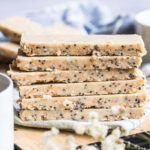 Frozen Coconut Macadamia DIY Energy Bars Recipe Author: Mark's Daily Apple
Frozen Coconut Macadamia DIY Energy Bars Recipe Author: Mark's Daily Apple  Prep Time: 10 min
Prep Time: 10 min  Cook Time: 30 min
Cook Time: 30 min  Total Time: 40 min
Total Time: 40 min  Yield: 12-14 bars Diet: Gluten Free
Yield: 12-14 bars Diet: Gluten Free  Print Recipe
Print Recipe  Pin Recipe Description
Pin Recipe Description Frozen Macadamia Coconut Energy Bars – a low-carb, low-sugar, homemade snack that satisfies.
Ingredients1 cup dried coconut
1.5 cups macadamia nuts
1/2 cup coconut oil
2 tbsp. chia seeds
1 tsp. vanilla extract
Pinch of salt
InstructionsPreheat your oven to 350 degrees Fahrenheit. Lay the coconut out on a sheet pan or baking dish and let it toast for 5-15 minutes, or until the coconut is golden. The length of time it takes for the coconut to toast will depend on its size and thickness, so watch it closely to prevent burning. Once the coconut is toasted to your liking, remove it from the oven and allow it to cool.
Place the macadamia nuts in a food processor and blend. Once the nuts begin to crumble and turn into a paste, add the coconut oil and process until smooth. You may need to scrape the sides of the food processor down once or twice in between processing.
Add the toasted coconut, chia seeds, vanilla and salt and pulse or blend until a chunky paste forms, or until the coconut is just incorporated into the macadamia mixture.
Line a 8”x8” pan with parchment paper and pour the macadamia mixture in. Place the pan in the freezer for at least 30 minutes.
Take the pan out of the freezer and lift the parchment out. Use a knife to cut the macadamia coconut square into 12 or 16 pieces. Keep leftover pieces in the freezer.
NotesFeel free to add more chia seeds if you’d like.
You can drizzle some nut butter or dark melted chocolate on the bars that sounds good to you.
Make sure to keep them stored in the freezer so they stay firm and solid.
We used thick pieces of dried coconut, but you can use thinner flaked coconut as well.
 Category: Treats, Snacks
Category: Treats, Snacks Method: Freezer Nutrition Serving Size: 1/12 recipe Calories: 283.8 Sugar: 1.5 g Sodium: 15.7 mg Fat: 29.2 g Saturated Fat: 16.1 g Unsaturated Fat: 11.28 g Trans Fat: 0 Carbohydrates: 5.1 g Fiber: 3.3 g Protein: 2.3 g Cholesterol: 0
Method: Freezer Nutrition Serving Size: 1/12 recipe Calories: 283.8 Sugar: 1.5 g Sodium: 15.7 mg Fat: 29.2 g Saturated Fat: 16.1 g Unsaturated Fat: 11.28 g Trans Fat: 0 Carbohydrates: 5.1 g Fiber: 3.3 g Protein: 2.3 g Cholesterol: 0 Keywords: energy bars recipe
 Did you make this recipe?
Did you make this recipe? Share a photo and tag Mark's Daily Apple — we can't wait to see what you've made!
The post Frozen Coconut Macadamia DIY Energy Bars Recipe appeared first on Mark's Daily Apple.



April 9, 2021
New and Noteworthy: What I Read This Week — Edition 125
 Research of the Week
Research of the WeekThe earliest known modern humans in Europe were products of a recent coupling between humans and Neanderthals.
How your face and body morphology influence how threatening you appear to others.
Thru-hiking—at least as commonly practiced—can impair vascular health.
In rodents, early life sugar consumption impairs later life cognition, perhaps via changes to gut bacteria.
Episode 481: Dr. Caroline Leaf: Host Elle Russ chats with communications pathologist and cognitive neuroscientist Dr. Caroline Leaf, an expert in using direct mind input to change how you think.
Episode 482: Dr. Greg Kelly: Host Brad Kearns chats with Dr. Greg Kelly about circadian strategies for fat loss and longevity.
Health Coach Radio: Erin and Laura chat with Charlene Gisele, who went from high-powered corporate lawyer to higher-powered health coach.
Media, SchmediaEveryone needs to go outdoors on a regular basis.
L0st Golden City discovered in Egypt.
Interesting Blog PostsHow vegetarian politics is preventing India from truly addressing its diabetes epidemic.
How and why did the Aztecs sacrifice so many humans?
Social NotesBetter get those hibernating bears on statins!
Everything ElseIsn’t this how Planet of the Apes begins?
Isn’t this how The Walking Dead begins?
Turns out that Baltic amber is chock-full of promising pharmaceuticals.
Physical strength and anxiety levels.
Things I’m Up to and Interested InHow about that: For 2 million years, humans were apex predators eating mostly fatty meat.
Important reminder: Sunlight works.
Rocky’s manager knew: No sex before squats.
This is terrible: Dog-napping on the rise in the UK.
This seems abusable: Sampling DNA from ambient air.
Question I’m AskingDo you think thru-hiking can be healthy if you do it right?
Recipe CornerOutstanding Brussels sprouts recipe.Eggplant beef casserole.Time CapsuleOne year ago (Apr 3 – Apr 9)
Should You Try Intermittent Fasting While Doing Long-term Keto? — Well, should you?How to Strengthen Tendons and Ligaments for Injury Prevention — It’s not just about the muscles.Comment of the Week
“The British have a fascination with naming types of birds after female epigamic displays. They already have tits (e.g., marsh tits and great tits), and boobies (e.g., the blue footed booby). Now it looks like they have a ‘knocker’. The real question, though, is ‘Are all knockers white?'”
-Great observation, Aaron.
(function($) { $("#dfYekHW").load("https://www.marksdailyapple.com/wp-ad..." ); })( jQuery ); 
The post New and Noteworthy: What I Read This Week — Edition 125 appeared first on Mark's Daily Apple.



April 8, 2021
Ask a Health Coach: Sleep Deprivation, Cortisol Spikes, and Cohabitating with a Twinkie Eater
 Hey folks! In this week’s edition of Ask a Health Coach, Erin is answering your questions about how to offset the effects of a poor sleep routine, dealing with a difficult partner, and which is more important for optimal health: low stress or a Primal diet. Thanks for all your questions. Keep them coming in the comments or over in our Mark’s Daily Apple Facebook group.
Hey folks! In this week’s edition of Ask a Health Coach, Erin is answering your questions about how to offset the effects of a poor sleep routine, dealing with a difficult partner, and which is more important for optimal health: low stress or a Primal diet. Thanks for all your questions. Keep them coming in the comments or over in our Mark’s Daily Apple Facebook group.
Christopher asked:
Any strategies for countering the detrimental effects of not getting enough sleep? Preferably ones that don’t involve caffeine. My work schedule and family responsibilities are making it difficult, most of the time impossible, to get enough sleep during the week and sometimes on weekends too. I also have to wake up hours before sunrise to get ready for work, and naps during the day are impracticable.
The short answer is, you can’t offset it. No amount of deep breathing, fasting, cold showers, or B3 supplements can trick your body into believing it got a glorious, uninterrupted night of shut eye when you regularly don’t get enough sleep.
These approaches just mask the damage. The body is miraculous, and it can adapt to a single night or two of staying up too late working or parenting or even *gasp* having fun, but a steady stream of sleep deprivation is setting you up for more issues down the road:
Long-term effects of not getting enough sleep:
Memory lossWeight gainDepression/anxietyHypertensionDiabetesCompromised immune systemThe list goes on. And really, you don’t want to see where it goes. That’s why instead of trying to off-set your non-optimal sleep schedule, work on improving it – even if that means taking small steps at first. And since it sounds like the amount of sleep you get each night is non-negotiable, going to bed earlier or sleeping in is totally off the table for you. That means, instead of focusing on quantity, you’ve got to focus on the quality of your sleep.
You’re not alone in managing exhaustion day-to-day. Most of my clients are busy working moms and dads who barely have time to think straight, let alone have a cushy after-hours routine. But there are some things you can do to move the needle on your sleep quality. Here are three practices I swear by, both for my clients and myself:
Turn off devices 1-2 hours before bed and if you can’t swing that, wear blue light blocking glasses. These glasses filter out those blue-violet light rays emitted from digital screens, which causes eye strain, headaches, and disruptions in the sleep cycle. And if you keep your phone near your bed (which I don’t recommend), don’t be tempted to check email in the middle of the night if you wake up.Remove or cover up any sources of light in your bedroom. Even tiny ones can impact your sleep, so use black-out blinds over your windows and duct tape over any blinking lights in the room. If that’s not possible, get yourself a sleep mask.Keep the temperature low, ideally at 60-67?F (15.6?-19.4?C). When your body warms up at night (which it always does) it interrupts your sleep, so turn the thermostat down before going to bed or consider getting a ChiliPAD – one of my favorite health gadgets ever!P.S. The Primal Health Coach Institute team is hosting a live Q&A webinar with Mark next week: 3 Things To Look For In A Health Coaching Program. What are the three things? 1) Health Science & Nutrition Education; 2) Health Coaching & The Art of Behavior Change, and; 3) Business Building & Entrepreneurship Skills. Join us, Thursday April 15th at 5:00pm Eastern Time. Mark and my colleague Laura Rupsis (PHCI’s Admissions Director) will dive into each of these three topics and discuss how health coaching education should go beyond just teaching students the basics of nutrition. They’ll also be taking some Q&A time with Mark! We hope you’ll join us.
Norbert asked:
I’m starting to realize that keeping stress low is just as important as proper eating, but everyone seems to focus on nutrition more than anything. I’ve eaten right and been stressed; but have felt better with low stress and not as good eating. Thoughts?
I like where you’re going with this, Norbert. We spend a lot of time talking about how food and exercise impacts biochemistry. And by “we” I mean all of us here at Mark’s Daily Apple and every other health focused website. Having a solid real food diet and daily movement routine are never wasted efforts, but as you’ve noticed, chronic stress (and a chronic output of cortisol) can put a serious damper on any benefits you’re getting from it.
So yeah, it makes sense that you feel better with less stress. But let me ask you this: why does it have to be one or the other? Can you chip away at having lower stress and better eating habits?
Meticulously watching your macros, counting calories, and overthinking everything that goes into your mouth is really stressful. I’m not saying that’s what you’re doing, but if you are, maybe knock it off. Diet culture tells us that to “eat properly” there are rules that need to be followed to a tee. And honestly, I’m over it.
What if you decided you were going to stop buying some of the “not as good” foods you’re eating and replaced them with better options? What’s one simple thing you can replace in your day to start to move into the “proper eating” category?
Maybe it’s swapping soda for seltzer water. Or just starting your day with a protein forward meal that may just influence how your whole day goes.
Obviously high stress and a poor diet are a recipe for disaster (I’m talking everything from digestion issues and memory impairment to a lifelong imbalance of hormones and neurotransmitters). But this doesn’t need to be a this-or-that situation. Start small and make simple changes that can improve your diet without actively amping up your stress levels.
Anna asked:
I’m looking for advice and tips on dealing with loved ones (particularly the romantic kind) who do not understand and/or follow a primal lifestyle. I’ve been dating an amazing person for about half a year now, and he is receptive and open-minded, but I cannot for the life of me stop cringing inside when I watch him eat certain foods. I am having a hard time knowing when and how to say something and when to say nothing. I know that I can’t make anyone change, nor do I want to. I hope to mostly inspire through being a role model, but it drives me crazy inside. I don’t know what the balance is. Got any advice?
One of the biggest challenges of following a primal lifestyle, or really anything that goes against the grain of the Standard American Diet, is dealing with loved ones who aren’t on the same page. As you know, there are tons of studies on the consequences of eating processed snacks, industrialized oils, and non-food food items, but that doesn’t stop people from consuming them.1 Clearly, living with someone who agrees with that science doesn’t either.
And you’re right. You can’t change someone’s behaviour. Acting as a role model is a much saner way to go. But even that has its challenges. If you’re expecting your actions to influence your partner’s habits and they don’t, that will leave you disappointed, angry, or even resentful.
You might be saying to yourself, “can’t they see how great I feel when I eat this way?!” and totally expect them to follow suit. Everyone has their own relationship with food. Your significant other has every right to decide if a primal diet is right for them – even if they see how great you feel when you eat that way.
Listen, I have lots of clients that are in your shoes. One half of a couple decides they’re done feeling foggy and fatigued and are ready to make a change. The other half has zero interest in doing so.
I’ll tell you the same two things I typically tell them:
This is YOUR health journey. You’re the one who’s decided to eat this way, not your partner. Sure, it would be awesome if everyone in your household ate the same thing as you did, but that’s not realistic, it’s not fair to them, and honestly, it’s not necessary in order for you to be successful. Someone can choose to not live a Primal lifestyle and still be loving and supportive.Find some common ground. Although you cringe at your partner’s food choices, take a step back (and try and remove judgement for a sec if you can) and figure out what foods you both like eating. I’m sure they’re not eating Twinkies and mac-n-cheese all day, so find a favorite food you have in common and start there. You might find that the tension you feel between you isn’t as strong as you thought.What else would you add? Tell me in the comments.
(function($) { $("#df04hlL").load("https://www.marksdailyapple.com/wp-ad..." ); })( jQuery );
The post Ask a Health Coach: Sleep Deprivation, Cortisol Spikes, and Cohabitating with a Twinkie Eater appeared first on Mark's Daily Apple.



April 7, 2021
Learning Deadlifting: 10 Mistakes Almost Everyone Makes
[image error]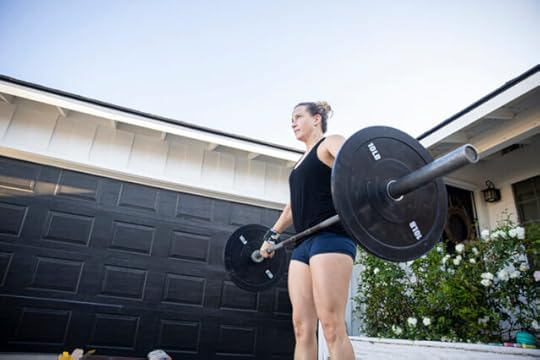 People fear the deadlift. For one, the name itself has the word “dead” in it. Two, they’ve been told for years—often by medical experts—that deadlifts are terrible for your back. “Oh, you might look/feel good now, but just you wait. One day you’ll regret it.”
People fear the deadlift. For one, the name itself has the word “dead” in it. Two, they’ve been told for years—often by medical experts—that deadlifts are terrible for your back. “Oh, you might look/feel good now, but just you wait. One day you’ll regret it.”
But they’re wrong. The basic idea of a deadlift is sound and the movement is a foundational human one. If you look at a kid pick something off the ground, they hinge at the hips, maintain a flat back, and pick it up by extending the hips (bringing them forward). Now, there are certainly wrong ways to perform a deadlift. Dangerous ways, methods that can (some might say will) damage your back and put your future health and basic ability to function at risk. The back and all it contains, including but not limited to the spine, is a foundational human structure. It connects to and connects every other part of the body to each other. It’s riddled with nerve endings that start along the spine and run down to every muscle in the body. You ruin your back and you compromise your ability to move through the world. So deadlift, but deadlift properly.
Today, I’m going to lay out proper deadlift form and highlight some common mistakes you might be making when performing it. That way you can safely and effectively integrate the deadlift into your training regimen.
Basic Deadlift Form
Here’s how to do the basic deadlift.
Stand with feet at jump width apart.Act as if you’re going to jump and then see where your feet naturally are. That is probably the strongest, most stable stance for you.
Bar over midfoot.Stand over the bar with the bar directly over the middle of your foot. Make sure you’re measuring the middle of your foot starting from the back of your heel, not the front of your ankle.
Brace your core, get tight while still upright.It’s important to brace your core and tighten up all over before grabbing the bar. Once you grab the bar and then try to tighten, it’s hard because your position is already compromised. Bracing before bending over improves cohesion and stability.
Break at the hips to grab the bar.Push your butt back and break at the hips, rather than “bend” at the back, while keeping your back flat. This will place the load on your glutes and hamstrings with your back as the supporting lever, rather than employing your back as the prime mover.
Try to “break the bar” with your hands to keep your shoulders in the right position.Imagine you’re trying to bend the bar in half. Doing so will keep your shoulders externally rotated and stable and strong.
Keep your back flat and extend your hips (hip thrust) to bring the bar up.You bring the bar up by extending your hips—thrusting them forward—with a flat, neutral spine.
Drag bar up your legs, don’t let it drift in front of you.Keeping the bar in contact with your legs as it rises will keep the immense weight close to your center of gravity, enforce proper form, and keep you safe.
Feel it in your glutes and hamstrings, like you’re pulling against the floor.You should feel the exercise in your glutes and hamstrings.
Stand up straight.At the top of the pull, you should be standing up straight. Don’t lean back, don’t arch your back. Just be straight and tall.
Lower the weight the same way you initiated the initial unweighted descent.Lowering the bar should look the same as the initial descent without the weight: break at the hips, flat back, staying tight.
10 Common Deadlifting MistakesWhat are some common mistakes people make when deadlifting? How can you fix them?
1. Pulling with rounded back.This compromises strength by creating a “floppy lever” and leaves you open to injury.
2. Allowing your back to round under load.This might be the most dangerous. Once your back position is set, don’t stray from it. Some people (advanced powerlifters who know what they’re doing; I don’t recommend) may pull deadlifts with slightly rounded backs, but no one allows a back to round in the middle of the lift. The nuance is important.
3. Bending at the back rather than breaking at the hips (reach back with your butt)Bending at the back makes your lower back the prime mover. The back is not a “mover,” it’s a stabilizer. It resists movement, and that’s how it builds strength. Breaking at the hips establishes the glutes and hamstrings as the prime movers and the back as the resister.
4. Bar too far in front of youThe reason for the “drag bar up legs” is to protect your back and improve your performance. If the bar drifts in front of you (away from contact with your legs), the load placed on your back increases dramatically.
5. Trying to brace and tighten up after grabbing bar.Don’t try to brace when you’re already bent over. Brace when you’re standing, then descend to grab the bar. Get arranged before your lift.
6. Lifting the weight by extending the back, rather than the hips.Again, don’t lift with your back. Lift with your hips—glutes and hamstrings.
7. Squatting rather than deadlifting.A deadlift is not a squat. You don’t want to squat down and try to lift it up with deep knee flexion. It is a hip extension movement.
8. Overly arching your back.Sometimes, people will arch their back in an attempt to get tight and maintain a flat back. Doing so places the spine in a disadvantageous position. You want to brace your spine by engaging the musculature surrounding the discs, not by stacking your discs together in a hard arch. An arch feels stronger than it is.
9. Shins not vertical.Keeping your shins vertical will ensure the majority of the load is borne by your hips and posterior chain. As your shins angle too far forward, you turn the movement into a knee flexion-centric squat.
10. Letting your chest drop when lifting the bar.Even though you initiate the movement with the hips, the angle of your torso shouldn’t change. Keep your chest up as you drive your hips forward and lift the bar so that you’re entire body moves in concert. The deadlift is not a good morning.
If you’re not sure, it’s worth paying an experienced trainer to help you make the adjustments and learn to “feel” a proper deadlift. Once you’ve got it, you’ll be using more weight than other groups.
(function($) { $("#df0ttFG").load("https://www.marksdailyapple.com/wp-ad..." ); })( jQuery ); 
The post Learning Deadlifting: 10 Mistakes Almost Everyone Makes appeared first on Mark's Daily Apple.



April 6, 2021
How to Simplify Your Life: Streamline Your Food, Home, Workouts and More
 Stressed, anxious, overcommitted—the unholy trinity the undermines mental health and wellbeing for so many people today. I’d argue that chronic stress is the number one threat to health and happiness. Yes, even more detrimental than modern diets, being too sedentary, overexercising when we do exercise, and all the other ways we mismanage our genes nowadays.
Stressed, anxious, overcommitted—the unholy trinity the undermines mental health and wellbeing for so many people today. I’d argue that chronic stress is the number one threat to health and happiness. Yes, even more detrimental than modern diets, being too sedentary, overexercising when we do exercise, and all the other ways we mismanage our genes nowadays.
By and large, we accept chronic stress as a standard, even inescapable, part of life. To some degree, that’s true. It’s hard to detach from workplace demands, financial pressure, social media and other time sucks, and the generally frantic pace of modern life. That said, most of us have more control over our daily schedules, environments, and habits than we choose to exercise. We don’t set the boundaries we need, nor take even relatively small steps to mitigate life stressors. Why is this so challenging?
Paradoxically, simplifying life and making it easier almost always involves some investment of time and/or money up front. Don’t let this deter you. This is a short-term investment for long-term payoff, which you deserve.
Do What Works for You
The last thing any of us needs is more stress, and getting advice that’s not applicable or realistic can be super annoying. For example, I hate when people tell me to Marie Kondo my house. I like my stuff, and I don’t want to get rid of it. It’s put away in closets and the garage not bothering anyone. Leave me alone, minimalists!
With that in mind, take what you need from today’s post and leave the rest. Do something, though, to make your life a little easier.
Start With a Stress InventoryGet out a piece of paper and make a list of all the things that are weighing on you: major life stressors, but also the arguments that you have on repeat with your partner or kids, and small tasks you keep moving from one to-do list to the next instead of just taking care of them.
Next, separate your list into things you can control and things you can’t. For situations you can’t control, brainstorm ways to relieve your stress about them. For example, if you’re caring for a sick family member, could you ask friends to take turns driving your kids to sports practice or dropping off dinner? With stressors you can control, identify the steps that you’d need to take to alleviate them.
Here are some questions to ask yourself:
What is one way I can ask for help or one task I could delegate to someone else?What is one thing I could buy, or one person I could hire, that would significantly reduce my stress?What is one thing I could say no to (even if I already said yes)?What is one easy thing I could check off my list?Then, choose ONE to address. Just one. Take the first step.
Streamline your home cooking with ready-made sauces, marinades, and dressings to amplify your flavors with no extra effort. All made without gluten, sugar, industrial seed oils.
Getting Started is Often the Hardest Part
Asking for help, saying no, and tackling those nagging little tasks become easier the more you do them. Often it’s just a matter of breaking the inertia and getting started. Figure out what you need to feel calmer and more relaxed, then do it.
And don’t forget to reward yourself! Adulting is hard. Rewards can be an essential part of instilling new and better habits.
Ideas for Simplifying and Making Your Life EasierTechnology – Yay or Nay?Technology can increase or reduce stress depending on how you use it. Here are four ways you can use technology to your advantage:
Put a bill on autopay.Link your Google calendar to your partner’s or teen’s so you can see everything in one place.Calendars aren’t just for appointments and meetings. Use your calendar to make sure you have time for the things you want to do, not just the things you have to do. Also block off time to clean your house, connect with your partner, exercise, and practice self-care.Download an app or browser extension that will solve a problem for you. For example, my husband and I both put the AnyList app on our phones so we can share shopping lists or packing lists, which saves a ton of hassle and repeat trips to the store. The OneTab extension for Chrome has revolutionized my professional life. When you have a bunch of tabs open—because you fully intend to read those 15 articles you’ve pulled up—click the OneTab button. It saves all the websites in a list, then closes the tabs. No more staring at a sea of open tabs while your browser freezes. Do you know about Google Keep, a cross between Notes and Stickies in your Google apps?Set limits on technology, though. Set specific times to check email and social media, then stick to them. Turn off notifications. Put your phone in a different room. Download Inbox Pause so your email only gets delivered at certain times.
Email is a significant stressor for most people. If you dread your inbox, here’s what to do:
Set aside some time one day. Put on some music or a mindless TV show. Get a glass of wine or your favorite cocktail.Take a deep breath and open your email.Create folders and filters for emails you want to keep receiving but that you don’t want cluttering up your inbox.Once you’ve done that, unsubscribe from everything you don’t want anymore.The goal is to get to the vaunted “inbox zero,” then stay that way!Create PausesThe busyness of daily life can easily become overwhelming, so it’s important to build pauses into your days.
Use the Pomodoro technique.With Pomodoro, you do focused work for 25 minutes and then take a 5-minute break. Download an app like this one that lets you organize your to-do list and reminds you to stop for a breather. Use those breaks wisely:
Drink some waterMake a cup of teaGo outsideTake some deep breathsStretch or do a two-minute microworkoutWatch one cute animal videoListen to a song, either a calming one or a pumping-up one“Brain dump” in your journal for a few minutes to clear your mindGet a hugSchedule “do not disturb” blocks during the day.Use those times to focus on work uninterrupted, check something off your to-do list, or take a nap if you need it. Parents or caregivers who can’t carve out time every day, can you find an hour or two each week where a friend or neighbor kid could hang out with your kids to give you a break, even if you don’t leave the house? Maybe you and your partner could each take one Saturday afternoon a month where it’s just “you time.” Make sure it’s on the calendar!
Take a proper lunch break.This has been a game-changer for me during quarantine. It’s so easy to work straight through lunch or use your lunchtime to catch up on email or other tasks. Give yourself 20 to 30 minutes to eat and chill. Maybe check in with social media during this time, but even better, listen to some music and relax.
Implement a Morning Routine and Bedtime RoutineGetting routines in place can be a hassle, but once you have them established, they create both calm and structure in your day. Even though they might seem like obligations at first, routines actually give you less to think about because they become automatic. More routine = fewer decisions = more mental space.
What to include in your morning routineAdapt this to make sense for your life, but here are some ideas:
Get up, drink some water, make a cup of tea or coffee; do NOT look at your phone right awayStep outside and get some fresh airDo a meditation or breathing exerciseDo some gentle movement or, if you want, a structured workoutMake your bedTake a showerCheck in with your schedule and to-do list for the day only once you’ve gotten through your routine. I like to use a good old-fashioned planner, in which I only write in pencil. On Sunday nights, I fill in my calendar for the week and make to-do lists, both work and personal. Each morning I look my planner, see what’s on tap for the day, and adjust my to-do list based on what I got done the previous day.
Evening routineAgain, pick and choose what works for you:
Put on your blue-blocking glasses, of course, and put away electronicsSpend 10 or 20 minutes going around your home and picking up clutter, putting dishes in the dishwasher, wiping down counter—make it so you wake up to a clean(ish) homePrepare bags and lunches for school or work tomorrowLay out exercise clothes or pack a gym bagTake a showerMeditation or breathing exerciseRead a bookWhatever you do, start your routine early enough that you can go to bed on time. Having an evening routine will help you not get sucked into Netflix or Instagram at bedtime, too.
Simplify Your FoodIf you’re like me, you spend a lot of time in the kitchen, especially right now with kids and spouses all at home for every. meal. Here are some ways you can free yourself from spending your whole life in the kitchen:
Menu plan and/or meal prep
Prepare big batches of grilled chicken, shredded beef or pork, hamburger patties, hard-boiled eggs, and roasted vegetables. Wash and chop fruit and vegetables to grab quickly for snacks, salads, and stir-fries.
On Sunday night, pack lunches for the whole week. Make jar salads, egg muffins, and chia puddings to grab quickly.
Personally, I like the flexibility to decide what I’m eating each night, but other folks like to plan a week’s dinners in advance and do all the shopping at once. Pick what works best for you.
For simplicity’s sake, all your meals can be one meat + one vegetable, or repeat your favorite recipes over and over. There’s no reason that dinner has to be something new and exciting every night.
Embrace convenience
Use a meal delivery serviceOpt for frozen or pre-cut fresh vegetablesRaid the hot-food bar at the grocery storeUse rotisserie chicken as your base for everythingSimplify Your HomeI know, I know, I said that I hate when people tell me to Kondo my home. Still, I admit that it feels great to pack a box off to the donation center. You don’t have to get rid of everything that doesn’t bring you immense joy, but still—what do you have lying around that could give someone else more joy than it brings you?
That aside, if I can impart one piece of wisdom in this post, it’s that it’s easier to keep your home clean than to deep clean it when it’s filthy. If your living space is messy and causing you angst, block off a few hours this weekend. Check out my post about how to clean almost anything. Then get scrubbing.
Once your home is clean, break it down into simple daily tasks that maintain the cleanliness so you don’t have to do massive deep-cleaning again for a while. Put a bottle of all-purpose cleaner and some rags in the kitchen and every bathroom. Make a quick wipe-down part of your evening routine, as I said above (this is a great job for kids).
Clean bathrooms more thoroughly on Saturday, wash sheets and towels on Sunday, fold and put away laundry on Wednesday— whatever makes sense for your schedule. Delegate tasks to specific people, or use a chore chart with kids. One person cooks, another person loads and empties the dishwasher, that sort of thing. That way, there’s no question about whose turn it is.
Simplify Your WorkoutsIf you’re struggling to make movement part of your daily routine, put workouts in your calendar. Set aside that time and make it non-negotiable so you don’t get overscheduled and miss your “me time.”
On the other hand, if you’re flirting with overtraining and burnout, throw your training log out the window. Stop being regimented with your exercise. Leave your heart rate monitor at home.
Go for a less-is-more approach. As Mark says, JFW (just f&*$%ing walk). Focus on joyful movement, moving for fun. Sign up for the MDA Microworkout Challenge and only do formal exercise for a few minutes a day.
Embrace Good EnoughWhen life becomes too complicated, embrace the concept of good enough. Toss out your to-do list once you’ve crossed off the non-negotiable items. Say no to every extraneous invitation or work request without feeling the need to justify your decisions.
Stop exercising and just move your body around.
Get takeout.
Let your house be a little messy. Your kids don’t care if their laundry is folded; they can pull clean clothes straight from the laundry basket. Don’t make your bed.
Give yourself permission not to worry about stuff that really doesn’t matter in the long run. It’s good practice in this unpredictable world.
Summary: 8 Ways to Make Life EasierUse technology to your advantage.Reduce unnecessary email and social media use that increases stress.Create pauses in your day. Take breaks and give yourself time to breathe.Bookend your day with calming morning and evening routines.Spend less time in the kitchen with meal planning and prepping, and by embracing convenience options.Reduce clutter and take simple steps to maintain a clean home enviroment.Go for shorter, less regimented workouts; but make sure you’re blocking off time in your day so you have time to move your body.Remember that good enough is good enough. (function($) { $("#df4iV7C").load("https://www.marksdailyapple.com/wp-ad..." ); })( jQuery ); 
The post How to Simplify Your Life: Streamline Your Food, Home, Workouts and More appeared first on Mark's Daily Apple.



April 5, 2021
Is Alcohol Bad For You If You’re Not Addicted?
 What do we make of alcohol? In sufficient amounts, it’s a poison. It’s incredibly addictive. It destroys entire communities.https://www.ncbi.nlm.nih.gov/pubmed/3... It tears families apart and compels otherwise reasonable, upstanding individuals to commit terribly senseless acts.
What do we make of alcohol? In sufficient amounts, it’s a poison. It’s incredibly addictive. It destroys entire communities.https://www.ncbi.nlm.nih.gov/pubmed/3... It tears families apart and compels otherwise reasonable, upstanding individuals to commit terribly senseless acts.
On the other hand, it’s a powerful social lubricant. The good stuff tastes great and can enhance the healthfulness of certain foods while inhibiting the unhealthfulness of others. It’s fun, it’s pleasurable, and it brings real (if chemically enhanced) joy to people. Moreover, we have a long and storied history with alcohol. It’s been an integral part of human culture and society for thousands, if not tens of thousands, of years.
So, what’s the deal? Is it good, or is it bad? Is it poison, or is it a gift? Let’s take a look at both sides of the story, which, as is often the case, isn’t exactly black and white.
If you found this article because you suspect you may have an unhealthy relationship with alcohol, visit this page for more resources. Alcoholism is a serious issue for some people and I am in no way suggesting there is any “workaround” or excuse herein for someone with those issues, or that drinking, even in moderation, is part of a healthy lifestyle.
First, the downsides.
The Negative Aspects of AlcoholAlcohol Is a Toxin That Your Body Must Metabolize and Excrete
Our ability to break alcohol down into less toxic metabolites didn’t arise because of our tendency to seek out fermented fruits. Over the course of an average day, the average human digestive system produces about three grams of ethanol just from the gut flora fermenting the gut’s contents. If we didn’t have the ability to metabolize and detoxify ethanol, those three grams would add up real quick and represent a huge toxin load on our bodies.
After alcohol is consumed, a number of enzymatic reactions ensue. In the liver, an enzyme called alcohol dehydrogenase converts the ethanol to acetaldehyde, an incredibly toxic compound that’s been implicated in causing many hangover symptoms. An enzyme called acetaldehyde dehydrogenase converts the acetaldehyde into acetic acid, or vinegar, which is harmless unless you’re a cucumber. From there, you’re good to go. Sounds simple enough, right? Just let the enzymes do their thing. As long as you make those enzymes, the alcohol will be safely and effectively metabolized into table vinegar which can then be extracted to form a delicious salad dressing (that last part isn’t true).
Unfortunately, not everyone produces the same amount and quality of detoxifying enzymes. Many people of East Asian descent possess a dominant mutation in the gene that codes for aldehyde dehydrogenase, making it less effective. While they’re less likely to be alcoholics, folks with the mutation (characterized by a “flushing” upon ingestion) are at an elevated risk of liver damage and esophageal cancer.https://www.ncbi.nlm.nih.gov/pubmed/1...
Alcohol and Liver DamageWe usually talk about non-alcoholic fatty liver, a disease associated with sugar and fat intake coupled with inadequate choline to support the liver’s function. But notice that we have to qualify it with “non-alcoholic.” That’s because the most-studied type of fatty liver is alcoholic fatty liver. The mechanisms behind alcoholic fatty liver are myriad and multifaceted,https://www.ncbi.nlm.nih.gov/pmc/arti... but it ultimately comes down to the fact that you’re bathing your liver in a known toxin. Liver alcohol metabolism increases the NADH/NAD+ ratio, thereby promoting the creation of liver fat cells and a reduction in fatty acid oxidation. The result is added fat in the liver and impaired fat burning.
Acetaldehyde, especially if it lingers for too long, also induces inflammation in the liver, which can ultimately progress to full cirrhosis and liver failure.
Alcohol in moderation shouldn’t be a big concern, as long as you can limit yourself. Not everyone can.
Alcohol May Cause Cancer Under Certain ConditionsExcessive alcohol intake is an established epidemiological risk factor for several cancers,https://informahealthcare.com/doi/abs... including stomach, liver, and colon cancer (to name just a few; more than a dozen cancers are linked to alcohol abuse).
In the stomach and liver, alcohol dehydrogenase converts ethanol into acetaldehyde, which is inflammatory and toxic. Alcohol that makes it through the stomach into the small intestine is also oxidized into acetaldehyde, this time by gut flora. While the liver produces the necessary enzymes to break down acetaldehyde into acetic acid, our gut microbes aren’t so well equipped and the acetaldehyde is allowed to linger longer.
Alcohol Is AddictiveWhile I’d argue that being addicted to anything will have a negative effect on your life, if not your physical health, being addicted to alcohol is particularly harmful because of how toxic it is – especially the more you drink. Alcohol is less addictive than nicotine, crystal meth, and crack, but more addictive than heroin, intranasal amphetamine, cocaine, and caffeine.https://www.erowid.org/psychoactives/...
One’s susceptibility to alcohol addiction is often hereditary,https://www.ncbi.nlm.nih.gov/pubmed/1... too, meaning some people will be far more likely to become addicted than others.
Alcohol Consumption Disrupts Sleep (Even in Small Amounts)A nightcap is a misnomer. Sure, it’ll help you fall asleep, but your sleep won’t be any more restorative. It increases the incidence of sleep disruptions, and it perturbs the healthy sleep cycles.https://pubs.niaaa.nih.gov/publicatio...
Mocktail Recipes to Try: Dragonfruit Margarita, Blackberry Gin Fizz or Bubbly Whiskey Cherry Lemonade
Alcohol Affects Judgment and PerceptionEven though alcohol destroys a person’s ability to safely maneuver a motor vehicle, one in three car accidents that result in death involve drunk drivers.https://www.cdc.gov/motorvehiclesafet... Everyone knows that you shouldn’t drive drunk, but why does it keep happening?
A recent study even showed that just a single drink caused subjects to find “intentionality” in other people’s actions. Subjects who got the alcohol were less likely to view simple actions as accidental, rather than intentional. Thus, when you’re under the influence of alcohol, you’re more likely to take personal offense at the guy bumping into your shoulder, the lady stepping on your shoe, or the person “staring” at you from across the bar. Because, after all, they “meant” to do it, right?https://journals.sagepub.com/doi/abs/...
Alcohol Promotes Bad Food ChoicesEveryone who’s ever gotten at least a buzz from a glass or two of wine or a mixed drink has felt the often irresistible urge to snack, to order something salty, crunchy, and sweet from the menu, to beg the driver to swing by the greasiest fast food drive-thru.
This is a well-documented phenomenon. Alcohol affects both active overeating and passive overeating.https://www.ncbi.nlm.nih.gov/pubmed/1...
Active OvereatingActive overeating describes the conscious decision to “get some grub.”
Passive OvereatingPassive overeating describes the amount you eat once the food is in front of you.
Under the influence of alcohol, you tend to do more of either – or both. This wouldn’t be such a bad thing if you’re drinking at a Primal meet-up, where you’re surrounded by relatively healthy food, but that’s not where most drinking occurs.
Alcohol Makes You Feel HungoverWhat’s worse than a bad hangover? I’m unaware of anything, at least on a physical scale. Sure, you can mitigate the damage, but the fact that a hangover even exists tells us that whatever we’re ingesting that gave us the hangover is bad for us (in the amount we ingested, at least).
Okay, those were the not-so-great aspects of alchol. What about the positives?
Alcohol Does Have Positives, If You Are Able to Use It Correctly (Not Everyone Can or Should)Alcohol Improves Endothelial Function (With a Catch)Impaired release of nitric oxide from the endothelialhttps://en.wikipedia.org/wiki/Endothe... cells is strongly associated with cardiovascular disease.https://www.clinchem.org/content/44/8... Ethanol actually increases the production of nitric oxide,https://www.ncbi.nlm.nih.gov/pubmed/1... which dilates blood vessels, regulates blood pressure, induces vascular smooth muscle relaxation, and basically improves endothelial function. If you want good cardiovascular health, you want good endothelial function. However, it’s important to note that large doses of ethanol seem to decrease endothelial function,https:/www.ncbi.nlm.nih.gov/pubmed/18690862&... so caution is obviously warranted.
Alcohol Can Reduce StressA lot of people use a glass of wine or beer to “wind down” after a hard day. This sounds bad on the surface – you’re using alcohol as a crutch! – but really, if you have to choose between stewing in your stress hormones all day and night and having a drink or two to settle yourself down, I think the drink can be a better option for some people – particularly if the stress is going to impair your sleep and affect your relationships. You’ll want to identify and deal with the original source of the stress, of course, but some people may find a net benefit from having that drink.
Alcohol Promotes SocializingHumans are social animals, and we are happiest and healthiest when we have friends, loved ones, and spend quality time with them. Social isolation is a consistent and strong risk factor for increased mortality and morbidity (meaning it’s linked with earlier death and worse health in the days up until that death).https://www.ncbi.nlm.nih.gov/pubmed/2...
You shouldn’t base your socialization entirely on drinking alcohol, but it can certainly be a powerful enhancer of your social life. And if you’re having a couple of glasses of wine as you host dinner parties, hang out with friends, enjoy a candlelit dinner with your significant other, or throw a BBQ with your social circle, it will likely have a net positive effect on your health. Of course, this isn’t to say that alcohol is any way needed to have a good time in a social setting.
Alcohol May Reduce Post-prandial Blood Sugar and Lipid Peroxidation (when taken with a meal)Just like it says above, drinking alcohol (like wine, for example) with food may reduce postprandial blood glucosehttps://ajcn.nutrition.org/content/85... and the susceptibility of blood lipids to peroxidation.https://www.aviramlipids.com/red%20wi...
It Can Lower Iron Absorption (This Can Be Good or Bad)Although the conventional push is to increase the intake of iron from foods (especially via fortified grains), some people don’t actually need the added iron. If you have hemochromatosis, a genetic condition that probably arose in Europeans as a survival response to the bubonic plague, you are a hyper-absorber of dietary iron. Luckily, ethanol seems to inhibit the absorption of heme iron,https://www.ncbi.nlm.nih.gov/pubmed/7... the kind you find in red meat. Red wine is also effective at reducing non-heme iron absorption,https://ajcn.nutrition.org/content/61... an effect most likely due to the polyphenols present. That said, the entirely non-alcoholic black tea also inhibits iron absorption and has even been shown to reduce the frequency of blood-draws required in patients with iron overload.https://www.ncbi.nlm.nih.gov/pubmed/9... Coffee works, too.https://www.ncbi.nlm.nih.gov/pubmed/6...
Note that if you’re deficient in iron or at risk for deficiency, alcohol could be harmful for you.
How to Minimize the Negative Effects of AlcoholEat Food When You Consume AlcoholWhen you eat a meal, and your stomach is “full,” the pyloric sphincter – which controls the passage of food and drink from the stomach into the small intestine – closes up until your stomach can break down its contents. Any alcohol added to a full stomach will also spend more time being broken down by the relevant enzymes. If you drink on an empty stomach, the pyloric sphincter is wide open, and a greater proportion of alcohol will make it to the small intestine for immediate absorption.
Plus, as I mentioned earlier, drinking alcohol with food can reduce postprandial blood glucose and the susceptibility of blood lipids to peroxidation. Keeping your drinking around meals will let you take advantage of these benefits.
Choose Lower Proof Alcohol or Dilute SpiritsFrom an evolutionary perspective, consuming high-proof, concentrated alcohol is a relatively recent practice. Some accounts suggest that the Chinese were distilling rice liquor in 800 BC, while others say it wasn’t until the 12th century AD that distillation became commonplace across the “known” world. At any rate, one could certainly argue that alcohol with a low fluid content is an evolutionarily novel food item.
Less fluid means less “stuff” in your stomach, which means a more open and allowing pyloric sphincter, which means faster absorption through the small intestine. More fluid means more “stuff” in your stomach and a more restrictive pyloric sphincter and slower absorption. You could even make like the ancient Greeks and water down your wine, which some people seem to think actually improves the wine.https://www.nytimes.com/2010/07/dinin...
Choose Your Drinking Companions WiselyEven in adulthood, peer pressure-induced binge drinking is a reality. There’s actual research that found that if your group of friends gets absolutely obliterated every time you go out with them, you’re more likely to join in on the “fun.”https://www.ncbi.nlm.nih.gov/pubmed/1...
Conversely, if your friend group has a glass or two of wine with dinner or saves the “good stuff” for special occasions, you’re more likely to follow suit.
It’s the same concept as becoming an average of the five people you spend the most time with. Whose life do you want to emulate?
Drink Moderate AmountsAll the research suggesting health benefits to drinking revolves around “moderate drinking.”https://onlinelibrary.wiley.com/doi/1... This amounts to one or two drinks a day depending on who you ask, and depending on who you are (women are affected by lower amounts of alcohol than men).
They’re not talking about pounding shots, or drinking Long Island iced teas, or doing Jello shots (although the gelatin might help matters). They’re talking about a glass or two of something.
Have Everything Else in LineIf you want to drink and remain healthy, you should strive to eat healthy, exercise well, reduce stress, walk a lot, experience nature, hang out with friends and loved ones, get sun when available, avoid nighttime light exposure as much as possible, and every other lifestyle prescription I recommend. In short, alcohol can augment (or at least fail to impact either way) an already healthy lifestyle, but it probably won’t make a bad situation better.
What to Say If You Don’t Want to DrinkIt’s tough to find yourself in a social situation as the only one not consuming alcohol. Sometimes, it makes people wonder whether your choice to eschew alcohol is a part of a larger issue – Are they not drinking ever again? Is there a drinking problem? Are they judging me and my drinking?
Some days, I’m just not really wanting an alcoholic beverage. I’ve done a 45 day no alcohol experiment, or I’ll do a dry a month or more just because.
In those cases, I don’t draw attention to it. Sometimes, people notice and ask why, in which case I’ll reply, “I’m just not drinking today.” If they press the issue, just repeat yourself.
That line works whether you’re not drinking for a day, or a month, or ever again. You don’t have to make it a big thing.
Do I Drink?Full disclosure: I do drink (except when I don’t). My drink of choice is red wine, and I might have a glass or two in a sitting, but I never get drunk. Heck, I don’t even really get “buzzed.”
I have decided that small amounts of alcohol every now and then works with my individual biology. I don’t have any alcoholics in my family that I know of, I can stop at one or two without a second thought, and I don’t ever crave alcohol. If any of that was different, my stance on my own alcohol consumption would probably be different, too.
I’d never recommend that people take up drinking or continue drinking, but I also don’t see it as a great evil in and of itself. The dose and frequency make the poison; it’s just that depending on a number of factors, the dose that makes alcohol a poison might be lower or higher for you than for me. If your sleep is affected or you are the least bit “off” the next day, you probably surpassed your ability to effectively process it and you should factor that in to your choice and approach to drinking again.
Okay, that’s about it for me. Let’s open it up to you guys, now. I want to hear your thoughts on alcohol, especially whether it’s had a positive, negative, or neutral effect on your life and the life of those you care about. I want to hear how you’ve integrated alcohol into your otherwise healthy lifestyle (or not). Thanks for reading!
(function($) { $("#dfqHte1").load("https://www.marksdailyapple.com/wp-ad..." ); })( jQuery );
References https://www.ncbi.nlm.nih.gov/pubmed/3068262https://www.ncbi.nlm.nih.gov/pubmed/16287084https://www.ncbi.nlm.nih.gov/pmc/articles/PMC2633431/https://informahealthcare.com/doi/abs/10.1080/00365520902912563https://www.erowid.org/psychoactives/addiction/addiction_journal1.shtmlhttps://www.ncbi.nlm.nih.gov/pubmed/19785977https://pubs.niaaa.nih.gov/publications/arh25-2/101-109.htmhttps://www.cdc.gov/motorvehiclesafety/impaired_driving/impaired-drv_factsheet.htmlhttps://journals.sagepub.com/doi/abs/10.1177/0146167210383044https://www.ncbi.nlm.nih.gov/pubmed/15384320https://en.wikipedia.org/wiki/Endotheliumhttps://www.clinchem.org/content/44/8/1809.fullhttps://www.ncbi.nlm.nih.gov/pubmed/10235453https:/www.ncbi.nlm.nih.gov/pubmed/18690862https://www.ncbi.nlm.nih.gov/pubmed/22326307https://ajcn.nutrition.org/content/85/6/1545.longhttps://www.aviramlipids.com/red%20wine.pdfhttps://www.ncbi.nlm.nih.gov/pubmed/752260https://ajcn.nutrition.org/content/61/4/800.abstract?ijkey=dca53226b4ced251acd09215dff73843ca4dcf6b&keytype2=tf_ipsecshahttps://www.ncbi.nlm.nih.gov/pubmed/9824354https://www.ncbi.nlm.nih.gov/pubmed/6402915https://www.nytimes.com/2010/07/dining/28curious.html?pagewanted=all&_r=0https://www.ncbi.nlm.nih.gov/pubmed/18448417https://onlinelibrary.wiley.com/doi/10.1111/j.1530-0277.2010.01286.x/abstract
The post Is Alcohol Bad For You If You’re Not Addicted? appeared first on Mark's Daily Apple.



April 3, 2021
Soft, Springy Gluten-free Chocolate Cake Recipe (with Dairy-free Option)
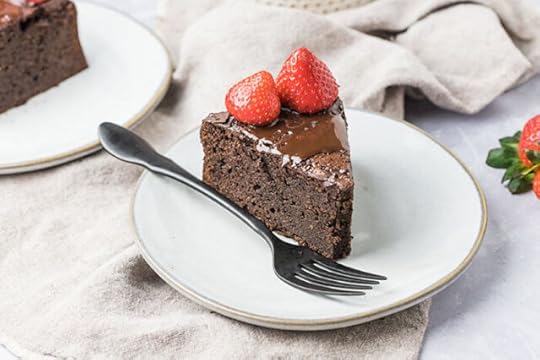 For years, I’ve been experimenting with gluten-free chocolate cake recipe after recipe, and most of the time, they turned out … okay. I’d add a little of this, hold back on that, take the the best of the crumbly one with good flavor, merge it with the tender one that isn’t nearly chocolatey enough. Add a melted chocolate bar or stick with cocoa powder? Dairy or no dairy? Extra egg to make it fluffy, or less egg for a richer, denser bite?
For years, I’ve been experimenting with gluten-free chocolate cake recipe after recipe, and most of the time, they turned out … okay. I’d add a little of this, hold back on that, take the the best of the crumbly one with good flavor, merge it with the tender one that isn’t nearly chocolatey enough. Add a melted chocolate bar or stick with cocoa powder? Dairy or no dairy? Extra egg to make it fluffy, or less egg for a richer, denser bite?
Well, today is a good day. After trying every trick, hack, and ingredient combination under the sun, I think I found the gluten-free chocolate cake recipe of my dreams (and yours, too).
What did it? This gluten-free chocolate cake has a secret ingredient that I’m going to start adding to a lot more of my flourless desserts.
This ingredient turned a kind of dry-looking, gloopy dough into a dreamy batter that I knew would bake up into the soft, springy cake that I remember from my gluten-happy childhood. And, I was right. This ingredient added stability (sometimes hard to come by in gluten-free desserts), moisture, and tenderness, and its subtle tanginess really woke up the rich chocolate flavor.
Do you want to know what the secret ingredient is? You probably have it in your pantry right now.
It’s mayo!
I know, mayo is about the least sexy dessert ingredient you can think of, but trust me on this one. When you’re working with an almond flour cake recipe, mayo adds something special. If you’re unsure, don’t let it keep you from trying this chocolate cake recipe. I promise you won’t taste it like you would in, say, a turkey sandwich. But it helps the flavors in your cake get to know each other, and your finished product develops a decadently fudgy texture after it’s been refrigerated.
Still hesitant? It’s only 1/4 cup of mayo. Don’t be scared.
Let’s make some cake.
Soft, Springy Gluten-free Chocolate Cake Recipe (with Dairy-free Option)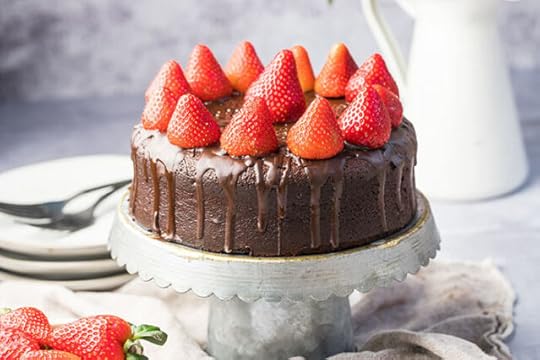 Ingredients5.5 oz. chopped 70% cacao or higher dark chocolate (use a dairy-free chocolate if you want to keep it dairy-free)1/3 cup honey (the kind that pours easily)1/4 cup coconut oil (refined or unrefined)1/2 tsp. almond extract1/2 tsp. vanilla extract1/4 cup mayo made with avocado oil4 eggs, room temperature and separated3/4 cup almond flour1/4 cup cocoa powder (plus more, for dusting the pan)1/2 tsp. salt1/4 tsp. baking powderAvocado oil sprayTo garnish: Additional dark chocolate to drizzle on top and berries
Ingredients5.5 oz. chopped 70% cacao or higher dark chocolate (use a dairy-free chocolate if you want to keep it dairy-free)1/3 cup honey (the kind that pours easily)1/4 cup coconut oil (refined or unrefined)1/2 tsp. almond extract1/2 tsp. vanilla extract1/4 cup mayo made with avocado oil4 eggs, room temperature and separated3/4 cup almond flour1/4 cup cocoa powder (plus more, for dusting the pan)1/2 tsp. salt1/4 tsp. baking powderAvocado oil sprayTo garnish: Additional dark chocolate to drizzle on top and berries
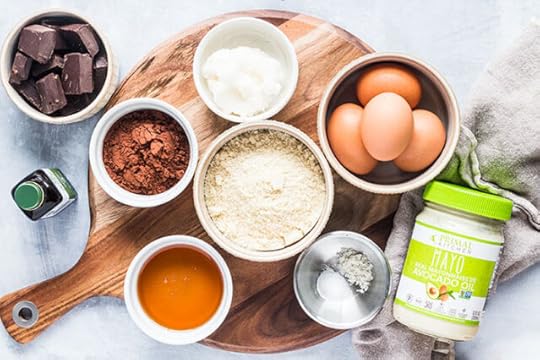
Preheat your oven to 350 degrees Fahrenheit. Melt the chocolate using a double boiler method. Fill a pot with a few inches of water and heat it over medium heat. Place the chocolate in a heat-safe bowl that is larger than the diameter of the pot. Once the water is hot, place the bowl over the pot. Use a spoon or spatula to mix the chocolate to encourage it to melt.
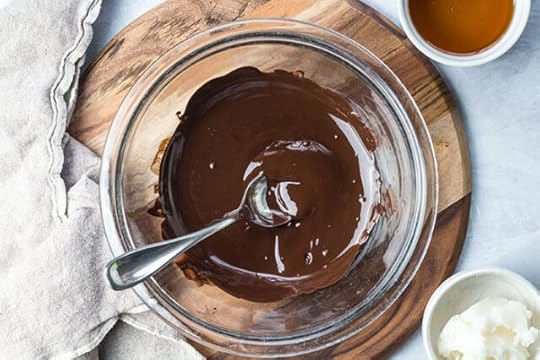 If the bowl gets too hot, you can turn off the heat. The residual heat of the water will continue to melt the chocolate. Mix until the chocolate is smooth and melted. Alternatively, you can melt the chocolate by microwaving it in 20 second increments until melted and smooth. Be careful with the microwave method though, it can burn quickly!
If the bowl gets too hot, you can turn off the heat. The residual heat of the water will continue to melt the chocolate. Mix until the chocolate is smooth and melted. Alternatively, you can melt the chocolate by microwaving it in 20 second increments until melted and smooth. Be careful with the microwave method though, it can burn quickly!
Stir in the honey, coconut oil, almond extract and vanilla extract until the coconut oil is melted and everything is combined.
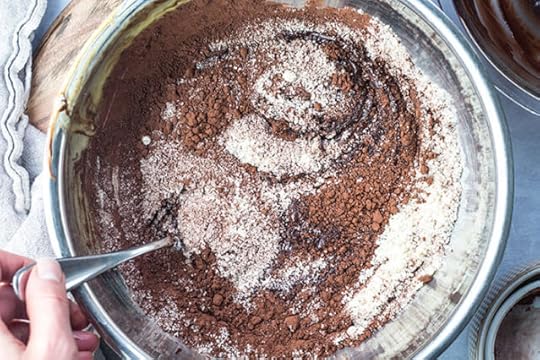
Set the chocolate mixture aside to cool.
In another bowl (or in the same bowl as the melted chocolate if the chocolate is cooled off), mix together the egg yolks and the mayonnaise.
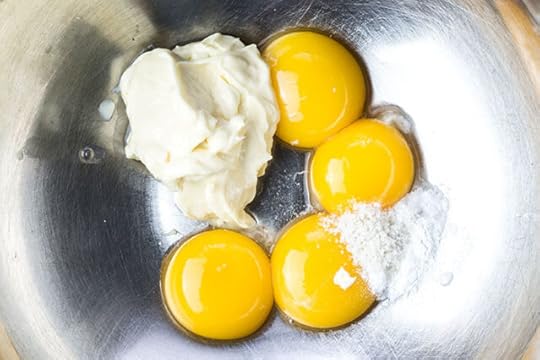 Mix in the almond flour, cocoa powder, salt and baking powder. Mix together the chocolate mixture and the mayo mixture in one bowl until everything is combined.
Mix in the almond flour, cocoa powder, salt and baking powder. Mix together the chocolate mixture and the mayo mixture in one bowl until everything is combined.
Place the egg whites in a large clean metal or glass bowl. Use a whisk or hand mixer to whip the eggs until stiff peaks form.
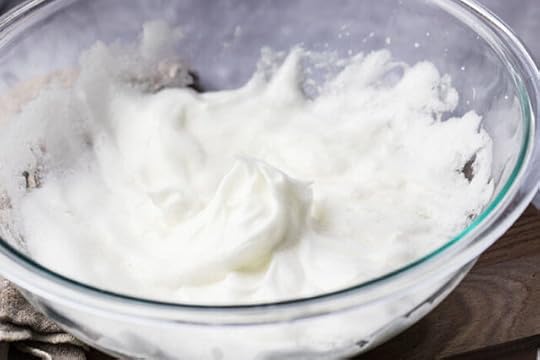 Use a silicone spatula to fold small amounts of the beaten egg whites into the batter, gently folding the whites into the batter in a sweeping motion to prevent deflating the egg whites too much. Continue folding until there are no streaks from the egg whites left in the batter.
Use a silicone spatula to fold small amounts of the beaten egg whites into the batter, gently folding the whites into the batter in a sweeping motion to prevent deflating the egg whites too much. Continue folding until there are no streaks from the egg whites left in the batter.
Spray your 7” springform pan with avocado oil. Use a sifter to sift some cocoa powder around the bottom and sides of the pan until the interior of the pan is covered with a thin layer of cocoa powder. Pour the batter into the pan and place the pan on top of a sheet pan to catch any batter that might seep out of the sides.
Bake the cake for about 30 minutes. After 30 minutes, reduce the heat to 325 degrees. Bake for an additional 7-10 minutes, or until the top of the cake has cracked slightly and feels springy to the touch.
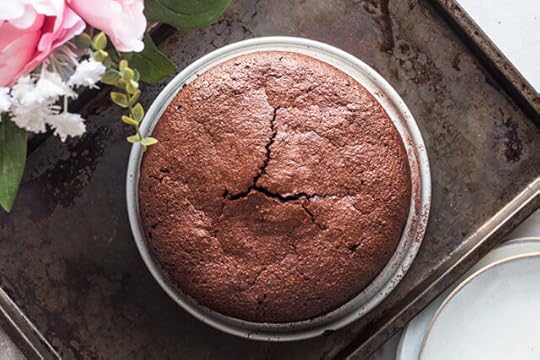
Allow the cake to cool, remove it from the pan, and top with melted chocolate, berries, or any toppings you’d like.




(function($) { $("#dfHmioh").load("https://www.marksdailyapple.com/wp-ad..." ); })( jQuery ); 
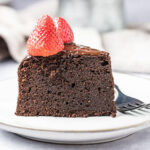 Soft, Springy Gluten-free Chocolate Cake Recipe (with Dairy-free Option) Author: Mark's Daily Apple
Soft, Springy Gluten-free Chocolate Cake Recipe (with Dairy-free Option) Author: Mark's Daily Apple  Prep Time: 20 minutes
Prep Time: 20 minutes  Cook Time: 40 minutes
Cook Time: 40 minutes  Total Time: 1 hour
Total Time: 1 hour  Yield: 10 serving Diet: Gluten Free
Yield: 10 serving Diet: Gluten Free  Print Recipe
Print Recipe  Pin Recipe Description
Pin Recipe Description Gluten-free, grain-free, and paleo chocolate cake recipe made with almond flour and a secret ingredient to keep it soft, moist, and tender.
Ingredients5.5 oz. chopped 70% cacao or higher dark chocolate (use a dairy-free chocolate if you want to keep it dairy-free)
1/3 cup honey (the kind that pours easily)
1/4 cup coconut oil (refined or unrefined)
1/2 tsp. almond extract
1/2 tsp. vanilla extract
1/4 cup mayo made with avocado oil
4 eggs, room temperature and separated
3/4 cup almond flour
1/4 cup cocoa powder (plus more, for dusting the pan)
1/2 tsp. salt
1/4 tsp. baking powder
To garnish: Additional dark chocolate to drizzle on top and berries
InstructionsPreheat your oven to 350 degrees Fahrenheit. Melt the chocolate using a double boiler method. Fill a pot with a few inches of water and heat it over medium heat. Place the chocolate in a heat-safe bowl that is larger than the diameter of the pot. Once the water is hot, place the bowl over the pot. Use a spoon or spatula to mix the chocolate to encourage it to melt.
If the bowl gets too hot, you can turn off the heat. The residual heat of the water will continue to melt the chocolate. Mix until the chocolate is smooth and melted. Alternatively, you can melt the chocolate by microwaving it in 20 second increments until melted and smooth. Be careful with the microwave method though, it can burn quickly!
Stir in the honey, coconut oil, almond extract and vanilla extract until the coconut oil is melted and everything is combined.
Set the chocolate mixture aside to cool.
In another bowl (or in the same bowl as the melted chocolate if the chocolate is cooled off), mix together the egg yolks and the mayonnaise.
Mix in the almond flour, cocoa powder, salt and baking powder. Mix together the chocolate mixture and the mayo mixture in one bowl until everything is combined.
Place the egg whites in a large clean metal or glass bowl. Use a whisk or hand mixer to whip the eggs until stiff peaks form.
Use a silicone spatula to fold small amounts of the beaten egg whites into the batter, gently folding the whites into the batter in a sweeping motion to prevent deflating the egg whites too much. Continue folding until there are no streaks from the egg whites left in the batter.
Spray your 7” springform pan with avocado oil. Use a sifter to sift some cocoa powder around the bottom and sides of the pan until the interior of the pan is covered with a thin layer of cocoa powder. Pour the batter into the pan and place the pan on top of a sheet pan to catch any batter that might seep out of the sides.
Bake the cake for about 30 minutes. After 30 minutes, reduce the heat to 325 degrees. Bake for an additional 7-10 minutes, or until the top of the cake has cracked slightly and feels springy to the touch.
Allow the cake to cool, remove it from the pan, and top with melted chocolate, berries, or any toppings you’d like.
NotesThis cake is mildly sweet as written with 1/3 cup honey and 70% chocolate. For a sweeter cake, you can add a little more honey or use a chocolate with a lower cacao percentage. For a more rich chocolate flavor that’s less sweet, you can use a darker chocolate, but I recommend 70% here.
This recipe provides instructions for baking in a 7” springform pan, but you can also bake it in an 8” pan or a loaf pan. A loaf will take 40-50 minutes to cook and a cake in a larger pan will take less time than a 7 inch.
Once the cake is cooled, cut it and store it in the fridge. The cake develops a divine fudgy texture once cold and is my preferred way to enjoy it!
Somehow have leftovers? This cake freezes well. Simply wrap it tightly prior to freezing to prevent freezer burn and to keep the cake from drying out.
 Category: Dessert
Category: Dessert Method: Baking Nutrition Serving Size: 1/10 of recipe Calories: 303.8 Sugar: 14.6g Sodium: 213.7mg Fat: 24.47g Saturated Fat: 10.7g Unsaturated Fat: .44g Trans Fat: 0g Carbohydrates: 19g Fiber: 2.6g Protein: 5.8g Cholesterol: 80mg
Method: Baking Nutrition Serving Size: 1/10 of recipe Calories: 303.8 Sugar: 14.6g Sodium: 213.7mg Fat: 24.47g Saturated Fat: 10.7g Unsaturated Fat: .44g Trans Fat: 0g Carbohydrates: 19g Fiber: 2.6g Protein: 5.8g Cholesterol: 80mg  Did you make this recipe?
Did you make this recipe? Share a photo and tag Mark's Daily Apple — we can't wait to see what you've made!
The post Soft, Springy Gluten-free Chocolate Cake Recipe (with Dairy-free Option) appeared first on Mark's Daily Apple.



April 2, 2021
New and Noteworthy: What I Read This Week — Edition 124
Hey folks! You may have noticed something a little different this Friday. Weekly Link Love is now our New and Noteworthy series. We’re following the same format that a lot of you have been reading for over a decade now: it’s a collection of interesting reads I found around the Internet over the week. Enjoy!
 Research of the Week
Research of the WeekOur taste for fermented food goes back millions of years.
Eating less animal protein and more fiber is linked to 5x greater kidney stone recurrence.
Eating more magnesium and drinking more beer is linked to fewer kidney stones.
Unprocessed meat still appears to be safe to eat.
Glycine and NAC, together, are great for aging.
Episode 479: Dr. Uma Naidoo MD: Host Elle Russ chats with Dr. Uma Naidoo about the powerful effects different foods can have on the brain.
Episode 480: Dr. Paul Saladino: Host Brad Kearns chats with Paul Saladino, who gives the compelling case for carnivore.
Health Coach Radio: Erin and Laura chat with Tim James, a high performance health coach and supplement expert.
Media, SchmediaEveryone needs to go outdoors on a regular basis.
Interesting Blog PostsHow to make saturated fat look bad.
On “life purpose.”
Social NotesAn update on how I move and eat.
Everything ElseI had a great time on Joe Rogan’s podcast. Listen to the full episode here or check out some clips.
I can’t wait to try blamb.
That must have felt good.
Things I’m Up to and Interested InThis is definitely true: Birdsong makes you feel good in nature.
Important reminder: Why we let tiny tasks grow large.
Life finds a way: How to get around Maine’s cannabis laws.
I wish I had one of these in my neighborhood: Door-knocking swan.
Big question: What is consciousness?
Question I’m AskingWhat does spring mean to you?
Recipe CornerOne of the best ways to eat asparagus.Paleo chicken pad thai.Time CapsuleOne year ago (Mar 27 – Apr 2)
Learning Through Play: 101 Ways to Keep Young Minds Occupied at Home – Some great ideas (works in adults, too).Dear Mark: Coronavirus Edition 2—COVID-19 Questions, Answered — Seems so long ago, doesn’t it?Comment of the Week
“On the subject of farm size.
The minimum farm size is one that will support the farmer and his family. Of course, this requires a smaller area on land that is more productive and fertile. Only an ivory-tower theorist would argue that the size of farms drives fertility, rather than the reverse.
What we actually SEE in my farming community is that farm productivity is strongly related to the expertise of the farmer and his willingness to adopt the most productive technology. It is the expert farmer who is most profitable and hence most likely to buy more land and increase the size of his holdings. Also, technology is expensive, which means that larger farms can more easily afford the most productive technology and pay the higher wages required to attract the best quality employees.”
–PeterW makes a good point.
(function($) { $("#dfO2HfG").load("https://www.marksdailyapple.com/wp-ad..." ); })( jQuery ); 
The post New and Noteworthy: What I Read This Week — Edition 124 appeared first on Mark's Daily Apple.



April 1, 2021
How to Let Go of Clutter without Feeling Like a Jerk
 Wondering why your feed is filled with tips on how to declutter your space? Clean mildew out of the showers. Swap your regular detergent for a better-for-the-environment one? It’s National Cleaning Week, or, as one of my clients put it, national “feeling bad because my house is a mess and I have zero interest in doing anything about it” week.
Wondering why your feed is filled with tips on how to declutter your space? Clean mildew out of the showers. Swap your regular detergent for a better-for-the-environment one? It’s National Cleaning Week, or, as one of my clients put it, national “feeling bad because my house is a mess and I have zero interest in doing anything about it” week.
Even though having a clean, organized space can increase your focus, reduce stress, and sometimes even improve your relationships, most people are far too busy to embrace the decluttering-is-awesome mindset,1 but is it really a lack of time that prevents you from doing it or is something else at work?
I’m willing to bet there are lots of things in your home you’re not using (hello, burnt up plastic food storage lids), but for some reason, you just can’t bring yourself to throw anything away or even donate it.
Why Can’t You Get Rid of Stuff?Jean Piaget, one of the founding fathers of child psychology, says the reason we’re so attached to our belongings is due to a psychological phenomenon called the Endowment Effect.https://www.behavioraleconomics.com/r... Basically, we put more value on items we own versus items we don’t own.
There have been tons of studies on this phenomenon too. Like this one where participants were divided into three groups, then asked to assist with research and given a reward for helping out.https://core.ac.uk/download/pdf/20626... The first group was offered two choices for their reward: a coffee mug or a bar of chocolate. Half chose the mug, and the other half chose the chocolate, which suggests that they valued each reward equally. In the second group, participants were given the mug first, then offered a chance to swap it for the chocolate bar, but only 11% took the researchers up on the offer. A third group started out with the chocolate bar, and most preferred to keep it instead of swapping it for the mug, which was offered after the fact.
The participants always put greater value on whichever reward they started off with.
Decluttering Has an Emotional ComponentAnother reason it’s so hard to part with your stuff? According to this study published in the Journal of Consumer Psychology, it all comes down to self-worth.https://www.sciencedirect.com/science... Rather than looking at the things you own as “mine” you think of them as part of who you are.
If you value relationships, you might have trouble parting with gifts. Kind of like you’re being disloyal to the person who gave it to you. If you value success, it could be challenging to part with items that serve as a reminder of your accomplishments, like an award at work or a decades-old trophy from your high school soccer days.
Some possessions also make you feel closer to people. Take family heirlooms for example. Maybe you’re having a hard time getting rid of a piece of artwork or jewelry that was passed down from your great grandma, because those items make you feel connected to her.
There are lots of reasons decluttering can make you feel bad. Here are a few more that might come up for you:
Sometimes attachments to things can go too far like in hoarding disorder, which is an exaggerated sense of responsibility and protection toward your belongings. That’s why people with this condition find it so hard to get rid of stuff — they feel like they have an obligation to own them.
Get Ready to Conquer Purging Paralysis
Even though we’re a few years past the Marie Kondo-ing “sparking joy” trend, knowing how to calmly and confidently declutter your space is a skill you’ll want to tap into. For the record, mastering this skill isn’t about having enough garbage bags and fresh Sharpies on hand. It’s about learning the proven behavior-change strategies that can take you from holding on to letting go.
Understand That You’re Wired This Way. Your brain is wired to value the things you own (this is the Endowment Effect in action), even if you don’t give them a second glance. Just knowing the psychological reasons why your possessions feel so important to you can help loosen your grip.Let Time Heal Your Attachment. You’ll always be reminded of how much your old jeans from college mean to you if they’re in plain sight. Try putting them in a box in the back of your closet or garage for a few months. They might be easier to donate away after some time has passed.Reframe the Situation. If getting rid of your things brings on feelings of guilt or sadness, try looking at your situation from a different perspective. Donating items is a great way to bring joy to someone else. And if you happened to sell something, you could get some much-needed cash out of the deal. Oh, and by the way, you’re not intentionally hurting someone by giving away a gift. Appreciate the happiness you got from receiving it, then move on.Recognize What You Value. Decluttering doesn’t mean purging everything you own. Take this opportunity to see what you really value, like a family heirloom or something you worked really hard at earning, and know that those items can still have a place in your home.Know You’re Braver Than You Think. Change is scary. And giving away or throwing away stuff you find meaningful can be one of the hardest things you do. But once you’ve done it once or twice and start to recognize the reasons you’re holding onto things, it becomes easier to let them go.5 Strategies for Letting Go of ClutterIt’s more than deciding what to keep, what to donate, and what to throw away. Decluttering has deep psychological roots and it’s totally understandable why it’s not as easy as filling a bag with giveaway items and driving to your nearest nonprofit. Whether you’re hesitant to purge old clothes, broken kitchen gadgets, or items you’ve inherited, or you just don’t know where to begin, use these strategies to take baby steps toward decluttering.
Understand That You’re Wired This WayLet Time Heal Your AttachmentReframe the SituationRecognize What You ValueKnow You’re Braver Than You ThinkWhat about you? Do you have a hard time letting go of things?
(function($) { $("#dfYF1QO").load("https://www.marksdailyapple.com/wp-ad..." ); })( jQuery ); 
The post How to Let Go of Clutter without Feeling Like a Jerk appeared first on Mark's Daily Apple.



March 31, 2021
Common Plank Mistakes to Watch Out For
 The plank feels like the simplest movement. Heck, it’s not even a movement, really: it’s holding a still position without movement. It expressly forbids movement. And yet it’s the simple exercises where things can really go wrong.
The plank feels like the simplest movement. Heck, it’s not even a movement, really: it’s holding a still position without movement. It expressly forbids movement. And yet it’s the simple exercises where things can really go wrong.
The plank is simple but not easy. When you’re in the plank position, every fiber of your being is resisting the pull of gravity. You must engage and tighten every inch of musculature in your body to resist collapse. To maintain coherence throughout the line your body forms. During a plank, you are quite literally holding the line against the most omnipresent force in the known universe.
At least in a push-up, you’re moving. You have something else to focus on. For a plank, a lot of the difficulty is mental. You’re just there in the same position, getting more and more tired with each passing moment. You have to sit with the pain.
Okay, so what’s the basic plank form?
Forearms or hands.First choose whether you’ll be doing it on your forearms or on your hands. If you’re on your forearms, this places more emphasis on the core. If you’re on your hands (as if you’re at the top of a push-up), there’s more emphasis on the shoulder girdle. Try them both out and see which ones work best for you. I’d recommend doing both varieties on a regular basis just to cover your bases.
Line up your elbows or hands directly below your shoulders.Imagine your arms are Greek columns holding up the temple that is your body. Those columns must be straight, they must be vertical to support the weight in the most advantageous position possible. If your elbows or hands aren’t lined up with your shoulders, the exercise will be harder and you might strain your shoulders.
More advanced versions of the plank have your hands/elbows drift ahead of your shoulders to increase the difficulty, but today’s post isn’t about those.
Form a plank – a straight line.
The technique is right there in the name of the exercise: plank. Form a plank, a single cohesive piece from head to toe. Tighten everything up. You should be a straight board.
Squeeze your glutes.A good cue is imagining you’re pinching a quarter between your butt cheeks. Really engage those glutes because they support the entire posterior chain and keep your hips from dropping.
Look at the ground.To keep your head in line with the rest of your body, loo at the ground. This promotes a neutral spine and head position.
Tuck your pelvis.Instead of arching teh back, do a slight pelvic tuck to really engage your abs. The pelvic tuck also allows you to use your quads and push against the ground with your feet. The plank is supposed to activate/engage every muscle of the body, not just the posterior, and the pelvic tuck promotes this.
With the slight pelvic tuck, you may feel like your butt is up in the air but it’s really not. Just feels that way.
Push hard against the ground.Push hard against the ground with your hands/forearms, like you’re trying to push the ground away from you, to protract your shoulder blades. This activates the serratus anterior, an often neglected muscle group.
Common Plank MistakesThe plank is simple enough, but people make mistakes. Here are the most common.
Hands/elbows not aligned with your shoulders.As you get more advanced you can slide your hands/elbows forward to increase difficulty, but if you’re just beginning your hands/elbows should be directly in-line with your shoulders.
Excessive arching of the back.People do this because they’re worried about their hips rising, but this takes the abs out of the picture, impairs the ability of the quads to engage, and can actually stress your lower back. Tuck your pelvis.
All the weight on the arms.Many people think of the plank as an upper body workout. You’re holding yourself up with the arms and contracting the abs, but the legs and feet are just kinda “there.” Don’t forget to actively press against the ground with feet and legs.
Not protracting the shoulder blades.Many coaches teach shoulder blade retraction during the plank, but this is a mistake. It takes the serratus anterior completely out of the exercise and shortchanges a lot of tension (and thus strength) you can be applying.
Going to failure.Stop short of form breakdown. It’s nice to test your max plank time every now and again, but don’t make it a habit. Training that way can instill poor motor patterns and increase your injury risk.
(function($) { $("#dfDGTWW").load("https://www.marksdailyapple.com/wp-ad..." ); })( jQuery );
The post Common Plank Mistakes to Watch Out For appeared first on Mark's Daily Apple.



Mark Sisson's Blog
- Mark Sisson's profile
- 199 followers


